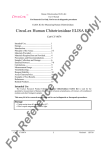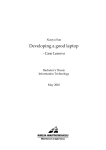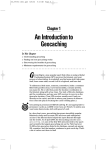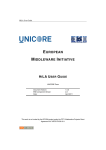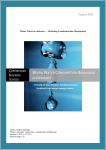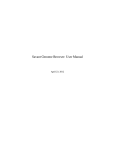Download Full Text Available - College of Health
Transcript
CLIMBER ACCESS TRAIL MAPPING & GPS VISITOR TRACKING IN INDIAN CREEK, UTAH Kathryn DeSirant White University of Utah, Department of Parks, Recreation, and Tourism Natural Resource Recreation Planning & Management Project Report University of Utah Matthew T.J. Brownlee, Ph.D. University of Utah, Department of Parks, Recreation and Tourism Nate Furman, Ph.D. University of Utah, Department of Parks, Recreation, and Tourism J. Adam Beeco, Ph.D. Outdoor Recreation Planner, Federal Energy Regulatory Commission Corresponding Author: Matthew T.J. Brownlee, Ph.D., Chair University of Utah Department of Parks, Recreation and Tourism 1901 E. South Campus Drive Annex C, Rm 1085 Salt Lake City, UT 84112 [email protected] E XECUTIVE S UMMARY ProjectConclusions · ThesampledpopulationofclimbersinIndianCreekwasfoundtoberelativelyhomogenous inperceivedskilllevel,experienceusehistory,specialization,anddemographics. · Sincetheparticipantswerefoundtobehomogeneous,findinga‘type’ofclimberwhomay spendmoretimeatanyonelocationthroughoutthedaywasnotpossible. · Sincetheparticipantswerefoundtobehomogeneous,findinga‘type’ofclimberwhomay becontributingmosttoinformaltrailswasnotpossible. · Itwasfoundthatmostparticipantswereconfusedatkeylocationsonroadsandtrails. · Inordertolessenconfusionaboutthelocationsofclimbingwallsandtrails,bothnarrative andarrowsignageshouldbeplacedatkeylocationsthroughoutIndianCreektodirect climbers. A BSTRACT Corporationsfollowemployeedrivinghabits,biologiststrackwildlife,andparentsconfirmthe locationofchildren.TheGlobalPositioningSystem(GPS)hasbecomesuchanintegralpartof modernlifethatitisnosurprisethatresearcherscannowmonitorwhererecreationiststraveland howmuchtimetheyspendatcertainlocations.InGPSVisitorTracking(GVT),adevicethatuses GPSiscarriedbyaparticipantandrecordsthelocationoftheparticipantatregularintervals. ResearcherscanthenuseGPSdatatoviewthetemporalandspatialdistributionofrecreationistsin complexrecreationenvironments. OnesuchcomplexrecreationenvironmentthathasincreasedinpopularityinrecentyearsisIndian Creek,Utah.BecauseoftheperfectlyparallelverticalfissuresinWingatesandstonewalls,thisarea hasbecomeaninternationalrockclimbingdestination.Rockclimbersaredrawntotheuniqueand difficultclimbsaswellastheopenspaceandprimitivefeelingthatIndianCreekprovides.This newfoundpopularityhasbroughthigherfrequenciesofclimbersalongwithnewmanagement concerns,includinglanddegradation,impactstonaturalresources,andcrowdingatpopular climbingareas.ThelandscapeofIndianCreekconsistsofvaststretchesofflatdesertcanyons separatedbytoweringsandstonewalls.Thistopographicalcomplexitymakesthetaskofprotecting naturalresourceswhilefacilitatingaccessdifficult.Consequently,themanagementgroupsofIndian Creekarebeginningtorealizethatthisincreaseinpopularityisquicklycausingnaturalandsocial impactsandthatgatheringinformationisanecessarysteptounderstandthefullscopeofthe issues. Thepurposeofthisstudywastoinformfuturelandmanagementdecisionsbyanalyzingcurrent trailsystemsandcomparingrockclimbers’characteristicstotheirtemporalandspatialpatternsof use.Theprimaryinvestigativequestionsforthisstudywere1)Dodifferenttypesofrockclimbers travelindifferentways,2)Whichrockclimberscontributetoinformaltrails,and3)Spatially,how doclimbersspendtheirtimeinIndianCreek? Thisresearchwasimportantandnecessarybecauseitinformslandmanagementdecisionsfor futuretrailmodificationsandimprovements,climbereducationprograms,andlandexchangesin IndianCreek.ThisresearchcontributestofutureresearchbydevelopingGPStrackingmethods, providesnewliteraturethatincorporatesgeography,recreation,andnaturalresource management,andoffersafoundationforGPSuseinfutureinvestigationsforvariousrecreationand leisureactivities. Methods Allstudyparticipantswereaskedtocompleteaquestionnairewithitemscapturingdemographics, specialization,self-perceivedskilllevel,andpastusehistory.Toanalyzesocialdatafromthe questionnaire,theresearcheruseddescriptivestatisticsafterstandarddatacleaningandensuring adequatevalidationofthemeasurements.AK-meansclusteranalysiswasusedtoattempttodivide climbersbasedontheirskilllevel,specialization,experienceusehistory,anddemographics. Component1focusedonanalyzingclimbers’temporalandspatialpatternsofusebytracking climbersfora24-hourperiod.Climberswereinterceptedattheircampsitesinordertoallowfor thenaturaldispersionofparticipantstotheirdesiredclimbingarea.ToanalyzeGPSdatafrom Component1,tracksfromeachparticipantwereclippedcomingtoandfromthecampground,to andfromtheparkingareaneartheclimbingwall,andtoandfromtheclimbingwall.Thismethod providedthetimesateachoftheselocationssothatthetotalamountoftimespentatcamp,driving, atparkingareas,hikingtotheclimbingwall,andattheclimbingwallcouldbeaveragedand comparedtothelengthofdaylighthoursaswellastheentire24-hourperiod. Component2focusedonanalyzinginformaltrailuseatfiveclimbingwallsofinterest.Climbing wallsofinterestareareaswithspecialmanagementconcernsincludinglanddegradation,resource overuse,informaltrailproliferation,andcrowding.Thesefivewallswerechosenbasedonthe highestuseareasfromComponent1.Theresearcherdefinedthe‘who’basedonthequestionnaire responsestodegreeofspecialization,self-perceivedskilllevel,andpastusehistory.ToanalyzeGPS datafromComponent2,onlyparticipanttracksthatincludedsectionsofinformaltrailsweretobe comparedtothequestionnairedata.Studyparticipantsweretobesplitintofourgroupsbasedon theamountoftimespentoninformaltrails,andanANOVAtestusingfourgroupswasgoingto allowtheresearchertodeterminewho(demographicallyandrecreationcharacterizations) contributesmosttoinformaltrails.Theresults,however,didnotallowthisanalysis. Results Thestudypopulationwasfoundtoberelativelyhomogeneousindemographics,specialization,selfperceivedskilllevel,andpastusehistory.Therefore,findinga‘type’ofclimberwhocontributes mosttoinformaltrailproliferationorspendsthemosttimehikingwasnotpossible.InComponent 1,itwasfoundthatmostclimbersspendthemajorityoftheirdaylighthoursattheclimbingwalls andtheyspendmoretimedrivingthanhiking.OriginallyinComponent2,aseriesofK-Means ClusterandANOVAtestswereperformedtocomparegroupsofclimberswhospentdiffering amountsoftimeoninformaltrails;however,thehomogeneousresultsdidnotallowtheresearcher todivideparticipantsintogroups.Therefore,Component2stillfocusedonanalyzinginformaltrail useatthefivemostusedclimbingwalls,andrecommendationsweremakeforsignagebasedonthe GPSVisitorTracking. Conclusion Studies,suchasthisone,thatexamine,assess,andmonitorrecreationists’impactstoprotected naturalareasandtheirrelationshipstoinfluentialfactorscanhelpidentifyandevaluateresource impacts,facilitatetheunderstandingofcausesandeffects,andprovideinsightintotheprevention, mitigation,andmanagementofproblems(Marion,1998;Leung&Marion,2000).Sincespatialand temporaldistributionsofusecontributetotheextentofrecreation-relatedresourceimpacts (HammittandCole,1998),informationgleanedfromGPSVisitorTrackinginIndianCreek,Utah providesthemanagementofIndianCreekandothernaturalareaswithclimberdistributionat climbingareasaswellasinsightintothecausesofnaturalresourceimpacts. TABLEOFCONTENTS 1 CHAPTER1:INTRODUCTION ....................................................................1 1.1 Purpose,Objectives,&PrimaryInvestigativeQuestions..........................................................................2 1.2 TheProblem.....................................................................................................................................................................3 1.3 BLM’sTrailManagementSystem..........................................................................................................................4 1.4 Rationale............................................................................................................................................................................5 1.5 KeyComponents............................................................................................................................................................6 2 CHAPTER2:SYNTHESISOFLITERATURE...............................................7 2.1 Trails....................................................................................................................................................................................7 2.2 InformalTrails................................................................................................................................................................7 2.3 MotivationsbehindInformalTrailDevelopment.........................................................................................8 2.4 SpatialAnalysisofInformalTrails........................................................................................................................9 2.5 ImplicationsforLandManagers.........................................................................................................................10 3 CHAPTER3:METHODS...........................................................................11 3.1 DataCollection.............................................................................................................................................................13 3.2 InteractionwithStudyParticipants..................................................................................................................13 3.2.1 InterceptLocations.........................................................................................................................................13 3.2.2 InterceptScript..................................................................................................................................................14 3.2.3 ContactForm......................................................................................................................................................14 3.2.4 VisitorQuestionnaire.....................................................................................................................................15 3.2.5 CollectingDataLoggers.................................................................................................................................16 3.3 CleaningData................................................................................................................................................................17 3.3.1 CleaningSocialData........................................................................................................................................17 3.3.2 CleaningGPSData............................................................................................................................................17 3.3.3 CleaningGPSDatainIndianCreek..........................................................................................................19 3.4 DataAnalysis................................................................................................................................................................19 3.4.1 QuestionnaireAnalysis.................................................................................................................................19 3.4.2 Component1:Time-UseStudy..................................................................................................................20 3.4.3 Component2:InformalTrailUse............................................................................................................20 3.5 PilotStudies...................................................................................................................................................................21 3.5.1 3.5.2 GPSTrackerTesting........................................................................................................................................21 Time-UseStudyofRockclimbersinIndianCreek..........................................................................29 4 OUTCOMES.................................................................................................32 4.1 ResponseRate&Sampling....................................................................................................................................32 4.2 QuestionnaireResults..............................................................................................................................................32 4.2.1 4.2.2 4.2.3 Demographics....................................................................................................................................................32 PastUseHistory................................................................................................................................................36 Specialization.....................................................................................................................................................38 4.2.4 Self-ReportedSkillLevel..............................................................................................................................40 4.3 GPSVisitorTrackingResultsandDiscussion..............................................................................................42 4.3.1 Component1:Time-UseStudyResults&Discussion...................................................................42 4.3.2 Component2:InformalTrailUseResults&Discussion..............................................................43 4.4 TrailMappingResults..............................................................................................................................................44 4.5 ParticipantTrailUse.................................................................................................................................................46 4.6 SignageRecommendationsfortheMostVisitedClimbingAreas......................................................47 4.7 InterpretationofGPSVisitorTracking............................................................................................................49 4.8 RecommendationsforFutureResearch.........................................................................................................51 4.9 Implications...................................................................................................................................................................52 5 REFERENCES:............................................................................................53 AppendixA–Manual:GPSTrackingofRockClimbersinIndianCreek,Utah AppendixB–Map:IndianCreekClimbingWalls&Trails AppendixC–Map:GPSVisitorTracking AppendixD–Map:SignageRecommendations AppendixE–Maps&RecommendationsforTop5VisitedClimbingAreas AppendixF–IndianCreekClimbingTrailQualityandAccess 1 CHAPTER1:INTRODUCTION IndianCreekCorridorislocated15milesnorthofMonticello,UtahalongHighway211,whichleads totheNeedlesDistrictofCanyonlandsNationalPark.Thiscorridorcontainsarchaeologicaland culturalresourcessuchasthepetroglyphsatNewspaperRockandrecreationopportunitiessuchas hikingandrockclimbing.TheBureauofLandManagement(BLM)managesthemajorityofthis26 milesectionasaSpecialRecreationManagementArea(SRMA),butthisareaalsoconsistsofland thatisstateandprivatelyowned.TheBLMissuespermitsforcattlegrazingandrecreationguiding andalsocaresforseveralfacilitiesinIndianCreekSRMAincludingroadways,threecampingareas, andfiveareaswithpittoilets.ThemainprivatelandowneristheNatureConservancy,whichin 1997boughttheDugoutRanch,whereHeidiReddhasruntheIndianCreekCattleCompanyfor overfortyyears.Heidiwasgivenalifeleaseof25acressotheranchcontinuestooperate.The NatureConservancymanagesthislandtofulfillthreestewardshipgoals:1)topreservethe property’secologicalandopenspacefeatures,2)tousethepropertyasaresourceforecological researchandnaturalhistoryinterpretation,and3)tocontinueahistoricranchingoperationwith theleastimpact.TheIndianCreekCattleCompanyholdsgrazingpermitsthroughmuchofIndian CreekSRMAonBLMland. BecauseoftheverticalfissuresintheWingatesandstonewallsthatlinethiscorridor,IndianCreek hasbecomeaninternationalrockclimbingdestinationinrecentyears.Rockclimbersaredrawnto theuniqueanddifficultclimbsbutalsotheprimitiveWildWest.Thenewfoundpopularityhas broughthigherfrequenciesofrockclimbersalongwithnewmanagementconcerns,includingland degradation,impactstonaturalresources,andcrowdingatpopularclimbingroutes.Asinterestin rockclimbinggrows,landmanagersofpopularrockclimbingareasarefacedwiththecomplicated taskofprotectingnaturalresourceswhilefacilitatingaccess.Sincethelandiscomplexwithvast stretchesofflatdesertcanyonsseparatedbytoweringsandstonewalls,thetopographical complexitymakesthetaskofmanagingrockclimbersdifficult.AnoverviewofIndianCreekandthe climbingareascanbeseeninFigure1. 1 Figure1a:MapofIndianCreek,Utah(FriendsofIndianCreek,2014). 1.1 PURPOSE,OBJECTIVES,&PRIMARYINVESTIGATIVEQUESTIONS Thepurposeofthisstudywastoinformfuturelandmanagementdecisionsbyanalyzingcurrent trailsystemsandcomparingrockclimbercharacteristicstotheirtemporalandspatialpatternsof use. Theprojectobjectivesincluded: 1. ToprovidetheBLMwithGPSdatafromclimberaccesstrailsinIndianCreek 2. Todevelopamapofrecreationresourcesandaccesstrails 3. Toidentifythetemporalandspatialdistributionofrockclimbers 4. Toidentifyinformaltrailsatfiveclimbingareasandcharacterizethetypeofrockclimbers thatmaybecontributingtothesetrails 2 Theprimaryinvestigativequestionsforthisstudywere: 1. Dodifferentrockclimbertypestravelindifferentways? 2. Whichrockclimberscontributetoinformaltrails? 3. Spatially,howdoclimbersspendtheirtimeinIndianCreek? Inordertoaddresstheresearchpurpose,objectives,andprimaryinvestigativequestions,this researchinvolvedseveralmethods.First,theresearcherusedGPStomapoverfiftyformaland informalaccesstrailstoclimbingwallsinordertoinventorycurrentformalandinformaltrail locations.ThisstepsatisfiedtheobjectivesofprovidingtheBLMwithGPSdatafromclimberaccess trailsandsuppliedthenecessarydatatocreateamapofrecreationresources.Second,the researcherperformedatwo-componentclimberusestudybycouplingGPStrackingofparticipants withaquestionnaire.Thefirststudycomponentfocusedonanalyzingthetemporalandspatial patternsofusebytrackingclimbersfora24-hourperiod.Thiscomponentprovidedtheresearcher withtemporalandspatialdistributiondatatoanswerthequestionofwhererockclimbersspend theirtimeinIndianCreek.Thesecondstudycomponentfocusedonanalyzinginformaltrailuseat fiveclimbingwallsofinterest.Thiscomponentallowedtheresearchertocomparetraillocations andquestionnairedataandprovidedinsighttothequestions‘Whichrockclimberscontributesto informaltrails?’and‘Dodifferentrockclimbertypestravelindifferentways?’. 1.2 THEPROBLEM Althoughoutdoorrecreationisoftenconsideredtobenonconsumptiveuse,overtimeitinevitably alterstheenvironment(Cole,2004).Sincethehumanandnaturalworldsaredeeplyintertwined, integratingsocialandecologicalresearchisnecessaryforabetterunderstandingofrecreation impacts.Thisresearchfallsintothecategoryofrecreationecology,whichaimstounderstand, examine,assess,andmonitorrecreationistimpacts(Marion,1998).Thisknowledgecanhelp identifyandevaluateresourceimpacts,facilitatetheunderstandingofcausesandeffects,and provideinsightintotheprevention,mitigation,andmanagementofproblems(LeungandMarion, 2000). Currently,theMonticelloFieldOfficeoftheBureauofLandManagement(MonticelloBLM)is realizingthepopularityofthisareatotherockclimbingcommunity.TheMonticelloBLMisalso realizinghowthisnewfoundpopularityisquicklycausingvariousimpacts,naturalandsocial,and thatgatheringinformationisanecessarysteptounderstandthefullscopeoftheissues. ThisresearchprovidestheBLMwithasolidbaseofinformationonrockclimbertime-useand potentialareasofoveruse.Withsevereoveruse,historical,cultural,andnaturalresourcesbecome 3 threatened,whichcanleadtodirectmanagementstrategies.Thesetypesofmanagementstrategies canleadtorecreationistdissatisfaction.Byinformingmanagementdecisionswithvaluabledata suchasaccuraterecreationisttime-useinformation,managementcanmakeappropriatedecisions whileallowingforcontinuedaccessandsenseoffreedomforrecreationists. Studies,suchasthisone,thatexamine,assess,andmonitorrecreationistimpactstoprotected naturalareasandtheirrelationshipstoinfluentialfactorscanhelpidentifyandevaluateresource impacts,facilitatetheunderstandingofcausesandeffects,andprovideinsightintotheprevention, mitigation,andmanagementofproblems(Marion,1998;Leung&Marion,2000).Sincespatialand temporaldistributionsofusecontributetotheextentofrecreation-relatedresourceimpacts (HammittandCole,1998),informationgleanedfromGPStrackingrockclimbersinIndianCreek, UtahwillprovidemanagementofIndianCreekandothernaturalareaswithtypicalclimber distributionatclimbingareasaswellasinsightintothecausesofnaturalresourceimpacts. Sincetraditionalmethodsofcollectingspatialandtemporaldatacanbeinaccurateand burdensometoboththeresearcherandtheparticipant,GPStrackingofrecreationistsprovides moreprecise,accurate,andreliabledatathatisnotaslaborintensiveastraditionalmethods(Hallo etal,2012).InGPSvisitortracking(GVT),adevicethatusestheGlobalPositioningSystemis carriedbyastudyparticipantinordertorecordthelocationoftheparticipantatregularintervals. GVThasbeenaprovenmethodforunderstandingthetemporalandspatialdistributionof recreationistsincomplexrecreationenvironments. 1.3 BLM’STRAILMANAGEMENTSYSTEM IntheNationalTrailsSystemActof1968,Section3(a),Congressdesignatedthreeclassificationsof trailsforpublicuse–1)NationalHistoricTrails,2)NationalScenicTrails,and3)National RecreationTrails.TheBureauofLandManagement(BLM)managesover6,000milesofpublicuse trailsthatareclassifiedwithintheNationalTrailsSystem(BLM,2009).However,themajorityof trailsonBLMlanddonotfallintotheNationalTrailsSystemActsdesignations.Morethan16,000 milesofmultipleusetrailsaredistributedoverapproximately258millionacresofBLMland.The BLMmanagestrailsinaccordancewiththeBLMLandUsePlanningHandbookaswellasotherBLM DirectivesSystemsdocuments.EachFieldOfficealsohasitsowngoalsandobjectivesformanaging theirlandintheircurrentResourceManagementPlan(RMP).Twointernaldatabasesareusedas managementtoolsfortheextensiveBLMtrailsystem–theFacilitiesAssetsManagementSystem (FAMS)andtheRecreationManagementInformationSystem(RMIS). 4 SincemanytrailsinIndianCreekhavenotbeenaccuratelyrecordedandincludedinthese databases,theresearcherrecordedaccurateGPSreadingsonthelocationofclimbers’trailsin ordertoprovideafoundationforthefuturemanagementofIndianCreek. 1.4 RATIONALE Inanyresearch,theresearchernotonlywantsthereadertounderstandwhatheplanstodo,but alsowhytheresearchisbeingdoneatall(Maxwell,2012).Therationaleofastudyismeantto convincetheaudiencethatthestudyisworthdoing(Sirakaya-Turk,2011).Arationalemustbe meaningful,well-developed,defensible,clear,andaccurateinordertobeconvincingtoreaders (Alasuutarietal,2008).Therationaleforthesignificanceofastudycanbeachievedif1)itwillfilla gapinthebodyofknowledgeandliterature,2)itwillansweranunansweredquestionorsolvea problemthathasnotbeensolved,and/or3)theoutcomeofthestudywillresultinafindingthatis importanttothefield(Sirakaya-Turk,2011). ThisresearchprovidesthemanagementofIndianCreekwithanunderstandingofthetemporaland spatialdistributionofclimbers,mapsofthelocationsofclimberaccesstrailsandseveralinformal trails,andinsightintotypesofclimberswhomaybecontributingtoinformaltrails.Withthe fragilityofthedesertlandscapeandincreasinginterestfromrockclimbers,IndianCreekisfacing thepressuresofoveruse,includinglanddegradation,impactstonaturalresources,andcrowding. ThisresearchprovidesmanagersofIndianCreekwithstrategiestohelppreventlanddegradation andimpactstonaturalresourceswhilemaintainingaccesstoanareathatisbelovedbyclimbers. Thisresearchisimportantandnecessarybecauseitinformslandmanagementdecisionsforfuture trailmodificationsandimprovements,rockclimbereducationprograms,andlandexchangesinIndian Creek,whileprovidingvaluableinformationforotherrecreationareasaswell. ThisresearchcontributestofutureresearchbydevelopingGPStrackingmethods,providesnew literaturethatincorporatesgeography,recreation,andnaturalresourcemanagement,andoffersa foundationforGPSuseinfutureinvestigationsforvariousrecreationandleisureactivities.While researchershaveperformedGPStrackingonrecreationistsinthepast(Halloetal,2012;D’Antonio etal,2010;Laietal,2007),fewhavecoupledGPSdatawithsocialdatafromquestionnaires. PerformingGPStrackingandcollectingquestionnairedataatthesametimeallowsforbetter understandingofspatialdistribution,useintensity,andtravelpatternsinrelationtorecreationist characteristicslikemotivations,desires,andabilitylevel(Beeco&Brown,2013).Sincethehuman andnaturalworldsaredeeplyintertwined,integratingsocialandecologicalresearchisnecessary forabetterunderstandingofrecreationimpacts. 5 Leisureandrecreationareimportanttooursocietyforavarietyofreasonsincludingphysicaland mentalhealth,satisfactionwithlife,socialinteraction,andfamilycohesiveness(vanBaaketal, 2003;Edingtonetal,1995;Crandall,1979;West&Merriam,2009).Inrecentyears,rockclimbing hasonlyincreasedinpopularitybothasarecreationactivityandasacompetitivesport(Sheel, 2004).Althoughoutdoorrecreationisoftenconsideredtobenonconsumptiveuse,overtimeit inevitablyalterstheenvironment(Cole,2004).Becauseofthepopularityofrockclimbing,places likeIndianCreekarebecomingimpactedinvariousways,includinglanddegradation,impactsto naturalresources,andcrowding.Byprovidinginformationonrockclimbercharacteristics, informaltrailuse,andtime-useatIndianCreek,thisresearchhopestocontributetocontinued accessforrockclimbersandotherrecreationistswhilemaintaininganacceptableimpacttonatural resourcesinmanyclimbingandrecreationareas. 1.5 KEYCOMPONENTS AsseeninTable1,theresearcherusedGPS,GIS,GPSVisitorTracking,andaquestionnaireto addresstheprojectgoalsandobjectives. Table1a:KeyComponentsofthestudy Component Importance Inthepast,collectingtemporalandspatialdatainvolvedhavingparticipantsdraw theirpathsandrecordtimesonblankmaps,whichistime-consumingand generallyunwelcomedbyrecreationists.SinceGlobalPositioningSystem(GPS) GPS datacollectionhasbecomeaccessible,thetaskofmonitoringspatialandtemporal useiseasierforthestudyparticipantandtheresearcherandcanallowformore accuratedatacollection. GeographicInformationSystems(GIS)assistedwithdataanalysis,mapcreation, GIS andtime-useanalysis. SmallGPSdataloggerswereusedto‘track’rockclimbersduringtheirdaily GPSVisitor activitiesinIndianCreek.Thistechnologyallowedforanaccurateviewofthe Tracking temporalandspatialuseofthestudyarea. MoststudiesthathaveusedGPStrackingofrecreationistshavefocusedon monitoringthespatialandtemporaldistributions(Halloetal,2012;D’Antonioet al,2010;Meijlesetal,2013).ThesestudiesprovethatGPSunitsarecapableof Questionnaires providingtheinformationnecessaryinunderstandinghowsocialtrailsdevelop. MergingGPStrackingalongwithquestionnairesandsocialconstructdatainthis studyallowedforadeeperknowledgeofhowsocialtrailsdevelop,whattypesof rockclimberscontributetosocialtrails,andwheresocialtrailsarelikelytoform. 6 2 CHAPTER2:SYNTHESISOF LITERATURE 2.1 TRAILS Atrailisapathortrackthroughroughcountry,suchasforest,thatismadeofadirtorstonesurface forthepassageofpeopleoranimals.Trailsaretheforemostsystemforrecreationiststoaccess desirablelocations.Paststudieshaveshownthatonlyabout15to20percentofrecreationists travelofftrailsinmostareas,andiftheydotravelofftrail,thesedistancesareusuallyminimal (Lucas,1978).Trailsareusedbypeopleasameanstotravelfromonelocationtoanother.In recreation,trailsallowrecreationistsaccesstonodes,whicharedestinationareasorlocationsof interest(Hammitt&Cole,1998).Nodescouldincludecampsites,ascenicoverlook,orawater source.Recreationistsdependontrailsystemsforsafetyanddirection.Thisdependencecanbea powerfultoolfordirectingusepatternsandeveninfluencingtheexperiencesoftherecreationists (Hendeeetal,1978). Recreationistsvarybyactivity,and,therefore,differentrecreationistgroupshavevaryingreasons forusingtrails(Manning,2011).Theprimarygoalofbackpackingistohikeforalongdistancein ordertogettoalocationofinterest.Thebackpackerthencampsinthatlocationofinterestand continuesonthetrailthefollowingday.Theprimarygoalofmountainbikingistorideabikeon trails.Thegoalcouldpossiblybetogettoasceniclocation,butridingonthetrailmaybethe primaryobjectiveaswell.Forthesetworecreationistgroups,thetrailisadrivingfactorofthe recreationexperience.Ontheotherhand,theprimarygoalforrecreationistsistoclimbrocks. Whilethetrailisusedtogetfromthecarorthecampsitetotherock,theintegrityofthetrailisnot thereasontorecreateandisnotthebiggestpartoftherecreationexperience. 2.2 INFORMALTRAILS Manylowimpactphilosophieshavebecomecommonplaceinthevocabularyofrecreationists: LeaveNoTrace,minimumimpacts,leaveonlyfootprints,takeonlyphotographs.Thisverbiage signifiesthatindividualsandgroupsarecapableofavoidingorminimizingimpactstonaturalareas withtheproperequipmentandknowledge(Pigram,1983). Informalorsocialtrailsaretrailsthatexistthatwerenotplanned,createdby,orofficially recognizedbythelandmanagers.Informaltrailscanoccurasjustonetrailsegmentorcanbe multiplelinked.Inareasofhighuse,theycanoftenbemadeupofhundredsofintertwinedtrails thatcreateawebofsociallyusedpaths.Informaltrailsareoftencreatednearalreadymanaged trails,inmeadows,inmuddystretchesoftrail,andonswitchbacktocreateamoredirectroute 7 (Coleetal,1987).Thesetypesoftrailscanalsooccurnearnodessuchascampsites,viewpoints,and watersources(Buckley,2004).Thesetrailsinevitablycauseharmtothenaturalenvironment. Evenwellplannedtrailscancauseimpactssuchassoilcompactionandvegetationlossandcan fragmenthabitatanddisruptwildlifemovementtothenaturalenvironment,butforinformaltrail development,theseimpactsareamplified(Pickering&Growcock,2009).Informaltrailsdissect largelandscapesintosmallersections,whichcanresultinalteredhydrologyandsoilmoisture, reducedhabitat,andtheinvasionofinvasivespeciesusinginformaltrailsaschannelsfortraveland dispersion(Forman,1995).Informaltrailscanalsocreatebarriersforcertainspecies,which reducestheabilityofanimalstodisperseseedsandreducestherateofanimalmovementonthe ground(Holmquist,2004).TheseverenatureofinformaltrailimpactswerebroughttotheU.S. NationalParkService’sattentionwhentheVERPmanagementframeworkselectedtheproliferation ofinformaltrailsasinimpactindicatorduetotheapparentecologicalandsocialsignificance(NPS, 2004). 2.3 MOTIVATIONSBEHINDINFORMALTRAILDEVELOPMENT Inordertobeginunderstandingthemotivationsbehindinformaltraildevelopment,itisimportant tounderstandmotivationstorecreate.Maslow(1954)theorizedthateveryonepossessesonlyfive basicneeds:physiologicalneeds,safety/securityneeds,belongingness/loveneeds,andselfactualizationneeds.Thistheorywassimplytheneedsthatpertainedtoallaspectsoflife,butitis importantinunderstandingdeeperrecreationmotivations.Whilemanywordscanbeusedto describewhypeoplearedriventorecreate,motivationsforleisureandrecreationcanbepared downtoincludethefollowing1)escape,2)enhancingrelationships,3)personalmastery,and4) winning(Dillard&Bates,2011).Neulinger(1974)hypothesizedthatleisurehadtwodimensions: 1)perceivedfreedom(i.e.theactivityhadtobeundertakenfreely,withoutconstraintor compulsion)and2)intrinsicmotivation,theconceptthatsatisfactionarisesfromengaginginthe leisureactivityitselfinsteadofhavinganexternalreward.Thesenaturalmotivationsgivehumans reasonandincentivetodosomethingorbehaveacertainway. Recreationistscanalsobeplacedintothecategoriesof‘casual’and‘serious’intermsoftheirleisure choices.Seriousrecreationcaptivatesitsparticipantswithcomplexitiesandchallenges,while casualrecreationrequireslittleornotraining.Rockclimbingisconsideredaserious,highrisk, extremesport(Selfetal,2007).Studiesthathaveresearchedmotivationinhighrisksportshave foundthatthesepeopletendtohavehighself-efficacy,highrisktakingbehaviors,andadesirefor 8 mastery.Theyalsohavetheabilitytoinhibittheinfluencesofanxiety,fear,andtherecognitionof danger(Slanger&Rudestam,1997). Whiletheremaybeanawarenessofthedamagesthatinformaltrailscandotoournatural resources,theproliferationofinformaltrailsappearstoonlycontinue.Sowhydopeoplemake socialtrailsandwhataretheprimarydriversfordoingso?Socialtrailsbeginwithjustoneperson leavingthemaintrailinordertoaccomplishsomething.Thiscanbetofindsolitude,findfirewood, getsomewherefasterthanthecurrenttrail,orgosomewherethatatraildoesnotalreadygo.Once onepersonleavestheexistingtrailsystem,thegrassiscompressedorthedirtisscuffledwhichcan triggerthenextpersonwhousesthetrailtoquestionwhetherornottousethesamenewer informaltrail(Manning,2011). Sincethetrailisnotthemainsourceofrecreationforrecreationists,itispossiblethatlessthought goesintothejourneytotheclimbthanthejourneyitself.Atrailissimplyameanstoanendfora rockclimber,sotheimportanceofthetrailintegrityandstructuredoesnotmatterasmuchasthe importanceofaclimb.Manytrailstoclimbingareasarecategorizedas‘climbers’trails.’Whenrock climbingstartedbecomingpopular,mostclimbers’trailswereinformaltrailsthatweredeveloped overtimebyclimbershikingstraightupahillsidetotherockwall.Sincethemotivationbehind recreationistsistoclimb,makingtheapproachhiketheshortestamountoftimeanddistance allowsformoretimespentclimbing.Sincetrailsthatoccuronthefalllineofahillsideare susceptibletoerosion,mostclimbers’trailsarenotdesirableandareinneedofmanagementand addedswitchbacks.Thestrongpersonalitytraitsandmotivationsofclimberscouldalsocontribute toinformaltrailproliferation(Kerr,2014).Sincetheendgoalistoclimb,thedistractionofseeinga rockwallbutnotquicklyandeasilyseeingaformaltrailcouldforcearecreationisttoforgehisown path. 2.4 SPATIALANALYSISOFINFORMALTRAILS Sinceinformaltrailsareoftenwidespreadthroughoutalandscapeandarequitevariablein structure,thedevelopmentofmonitoringprotocolsforinformaltrailsandtheirassociated indicatorshasbeendifficult(Manning,2011).Theextensivenatureofthesetrailsystemshasmade assessingandmonitoringinefficient(Marionandothers,2006).Spatially,thesetrailscanwidely differintheamountofspacetheytakeup–somecoveralargeamountofspacewithinafacilityand areobviouswhileothersaresmallandmaybedifficulttospot.Thesedifferencesininformaltrails havemadethemdifficulttomonitorandcreatesolutionsformanagementstrategiesthatfitacross theboard.Overtheyears,informaltrailshavebeenmonitoredusingoneofthreegeneral 9 approaches–estimates,extensivefieldinventories,ortheextractionofgeoreferencedimagerylike satelliteimagery. Traditionalmethodsofcollectingspatialdistributionsofusehaverequiredstudyparticipantsto tracktheirtravelroutesonblankmapsandrecordthetimespentatcertainlocations(Halloetal, 2012).Thistypeofdatacollectiononlybecomesunreasonableandcomplexwhenstudying recreationistsincomplextrailssystemsorwhentrailsareunmarked.Sincethesetraditional methodsofcollectingspatialandtemporaldatacanbeinaccurateandburdensometoboththe researcherandtheparticipant,GPStrackingofrecreationistsprovidesmoreprecise,accurate,and reliabledataandisnotaslaborintensive(Halloetal,2012).InGPStracking,adevicethatusesthe GlobalPositioningSystemiscarriedbyastudyparticipantinordertorecordthelocationofthe participantatregularintervals. 2.5 IMPLICATIONSFORLANDMANAGERS Sincestudieshavedemonstratedtheneedfordatacompilationovertimeonecologicalhealth effectsofinformaltrailproliferation(Leungetal,2011),managersshouldnotehowimportantitis tostartcollectingspatialdatafromrecreationistsandcontinuetocollectthisdata.Abetterviewof themanagementarea’sneedsorproblemareascanbeseenwhenlookingatspatialdistributionsof recreationistsovertime.Creatingwellthoughtoutinformationandeducationtechniques specificallytargetingthemanagementarea’srecreationistgroupscanassisttheon-the-ground effortininformingrecreationistsabouttheissuesrelatedtoinformaltrails.Creatingschool educationprogramsisanotherprovenwaytoeducateearlyandpreventinformaltrailcreationin thefirstplace(Browningetal,2012). Themostimportantimplicationforlandmanagersistounderstandthetypesofrecreationists spendingtimeintheirmanagementzone.Oftentimes,themotivationsofrecreationistgroupsare variedbytherecreationsport,age,orgender(Afthinosetal,2005;Whiteetal,1991).By recognizingwhatspecificrecreationistgroupsareusinganarea,managerscanbegintounderstand whattherecreationistsaremotivatedbyandeventuallywhytherecreationistsmaybecreating informaltrailsystems.Sincemanyinformaltrailsaredevelopedbecauseaneedisnotbeingtaken careof,managementmustallowforanopenlineofcommunicationandon-the-groundvisibilityto theirrecreationists.Whenlandmanagersunderstandhowandwhyinformaltrailsdevelop,they areabletoconsiderforfuturetrailconstructionormodificationsandimprovementsofexisting trails. 10 3 CHAPTER3:METHODS Thisresearchaimedtoanswerthreeprimaryinvestigativequestions:1)Dodifferentrockclimber typestravelindifferentways,2)Whichrockclimberscontributetoinformaltrails,and3)Spatially, howdorockclimbersspendtheirtimeinIndianCreek?GPSdatacollectioninthisstudyhad severalcomponentsinordertoaddresstheseprimaryinvestigativequestions: Initially,theresearcherhikedandtookGPSreadingsfromthemajorityoftheclimberaccesstrails withaTrimbleJuno.GPSreadingsforthecurrentrecreationfacilities(toilets,parkinglots, campgrounds)werealsotaken.Thisstepprovideddataofthecurrentresourcesavailabletorock climbersinIndianCreek. Component1focusedonanalyzingtemporalandspatialpatternsofusebytrackingrockclimbers fora24-hourperiod.Climberswereinterceptedattheircampsiteinordertoallowforthenatural dispersionofparticipantstotheirdesiredclimbingarea. Component2focusedonanalyzinginformaltrailuseatfiveclimbingwallsofinterest.Climbing wallsofinterestareareaswithspecialmanagementconcernsincludinglanddegradation,resource overuse,informaltrailproliferation,andcrowding. Originally, climbersweretobeinterceptedat thetrailheadorparkinglotofeachclimbingwallofinterestinordertofocusontravelpatternsat thatparticularclimbingwall;however,sincetheBLMdidnothaveastrongsenseofthemost popularclimbingareas,theGVTdatafromComponent1wasusedtofindthefivemostpopular climbingareas.Theresearcherdefinedthe‘who’intheresearchquestionsbasedonthe questionnaireresponsestodegreeofspecialization,self-perceivedskilllevel,andpastusehistory. Allstudyparticipantswerealsoaskedtocompleteaquestionnairewithitemscapturing demographics,specialization,self-perceivedskilllevel,andpastusehistory. 11 Table3a:Studycomponentsandapplicableinstrumentsandareasofuse Component GPSMappingof InformalTrails GPSVisitor Trackingfor InformalTrails Analysis GPSVisitor Trackingfor Time-use Analysis Questionnaire GPSMappingof ClimberTrails Instrument FocusAreaorInterceptLocation TrimbleJuno FivesitesdeterminedbyGVTmostpopularareas Canmore FivesitesdeterminedbyGVTmostpopularareas · · Canmore · · · · · Paper · Questionnaire · · · · · · · · · · · · · TrimbleJuno · · · · · · · · · · · · CreekPastureCampground SuperbowlCampground BridgerJackCampground CottonwoodCreekCampArea PrimitiveCampingAreas CreekPastureCampground SuperbowlCampground BridgerJackCampground CottonwoodCreekCampArea PrimitiveCampingAreas 1stMeatWall · 2ndMeatWall · 4x4Wall · BattleoftheBulgeButtress · BioturbationWall · BlueGrammaCliff · TheBridgerJacks · BrokenTooth · CatWall · ChurchRock · CliffsofInsanity · Critic’sChoice · DisappointmentCliffs · DonnellyCanyon · ElectionWall · FinWall · ForgottenTower · FrictionSlab · FringeWalls · · TheGash TheHappySubmarine · LavenderButte · LeftRambo · 12 NorthSixShooterPeak TheOptimator TheOriginalMeatWall PetrifiedHornetWall PistolWhipped PowerWall PublicServiceWall ReservoirWall SabbaticalWall Scarface SelfishWall ShockandAwe SinbadWall SixStarWall SlugWall SouthSixShooterPeak SparksWall Suburbia SupercrackButtress TechnicolorWall VitaminDWall TheWall WayRambo 3.1 DATACOLLECTION PleaseseetheManualofGPSTrackingRockClimbersinIndianCreek,UtahinAppendixAfor specificinformationontheGPStracker’sinitialset-up,uploading,anddatamanipulation. 3.2 INTERACTIONWITHSTUDYPARTICIPANTS 3.2.1 INTERCEPT LOCATIONS Thefirststudycomponentfocusedonanalyzingtemporalandspatialpatternsofusebytracking climbersfora24-hourperiod.Thiscomponentprovidedtheresearcherwithtemporalandspatial distributiondatatoanswerthequestionofwhereclimbersspendtheirtimeinIndianCreek.For Component1,thefourmaininterceptlocations:CreekPastureCampground,BridgerJack Campground,SuperBowlcampingarea,andthecampingareaalongCottonwoodCreekonBeef BasinRoad.Theseareascanbeseenbelow: Figure3a:Interceptlocations 13 Thesecondstudycomponentfocusedonanalyzinginformaltrailuseatfiveclimbingwallsof interest.Thiscomponentallowedtheresearchertocomparetraillocationsandquestionnairedata inordertocharacterizethetypeofclimberthatmaybecontributingtoinformaltrailsaswellas provideanswerstothequestions‘Whichrockclimberscontributetoinformaltrails?’and‘Do differentrockclimbertypestravelindifferentways?’.Interceptlocationswerethesameas Component1. 3.2.2 INTERCEPT SCRIPT Participantswereapproachedattheircampsite.Theywereinformedaboutthestudy’spurposeand objectivesandexpectationsasparticipants. Hi,mynameis_____________.I’mfromtheUniversityofUtah.Iamconductingastudyofthespatial distributionofclimbersinIndianCreek.IamaskingthatyoucarrythissmallGPSunitwithyouforthe next24-hours(Component1)/foryourtimeatthisclimbingarea(Component2)aswellasfillouta veryshortquestionnaire.Participationisvoluntaryandyourquestionnaireresponsesareconfidential. Resultsfromthisstudywillbereportedinbroadstatisticalterms.Wouldyoubewillingtoparticipate today? IfNo:OK.Thankyouforyourtime.Haveagoodday. IFYes:OK.Thankyouforagreeingtoparticipate.HereistheGPSunitandquestionnaire. Oncethequestionnairewascompleted:Thankyouverymuchforsupportingthisstudy.Pleasedrop thisGPSunitoffinthisdropboxattachedtothecampgroundkioskattheendoftodaywhenyou returntocamp. ParticipantswereaskedtocarrytheGPSLoggerontheirpersonfortheentireday.Theyhadtobe willingtoparticipateinthequestionnaireaswellascarrytheGPSunit.Theparticipanthadtobe campinginthesamelocationthefollowingnightinordertoreturntheGPStrackertothedropbox. Theresearchercollectedpersonalinformationonthequestionnaireincludingname,e-mail address,phonenumber,andcampsitelocationinordertoensuretheretrievaloftheCanmoreGPS units. 3.2.3 CONTACT FORM TheContactFormwasusedtorecordallinteractionbetweentheresearcherandclimbers.After approachingandreceivingaresponsefromaclimber,theresearcherrecordedwhethertheclimber 14 agreedorrefusedtoparticipateorhasalreadyparticipated,theparticipantnumberifheorshe agreedtoparticipate,thegroupsize,andgrouptype. Figure3b:ContactForm 3.2.4 VISITOR QUESTIONNAIRE Afteragreeingtoparticipateinthestudy,participantsfilledoutashortquestionnaireon5”x7” cardstockasseenbelow: Figure3c:QuestionnaireFront 15 Figure3d:QuestionnaireBack Theresearcherremindedtheparticipantthatthereweretwosidestothequestionnaire.Afterthe questionnairewascompletedbytheparticipant,theresearcherrecordedthedate,participant number(threedigitsstartingwith001),theclimbingareathattheparticipantwouldbeclimbingat thatday(ifknown),andthetimethattheGPSunitwasprovidedtotheparticipant. 3.2.5 COLLECTING DATALOGGERS ParticipantswereaskedtoplacetheGPSloggersinasecureddropboxatthecampgroundkiosk.If dataloggerswerenotfoundtobeinthedropboxthenextmorning,theresearchcollectedthemin person.Thedropboxwaslockedtothecampgroundkioskandhadasignaboveittoremind participantstodropofftheunit. 16 Secondarymeasuresforretrievalincludee-mailingandcallingtheparticipantatalaterdateand havingtheparticipantmailtheunittoeithertheMonticelloBLMofficeortheParks,Recreationand TourismDepartmentattheUniversityofUtah. 3.3 CLEANINGDATA 3.3.1 CLEANING SOCIALDATA Beforeanalyzinganytypeofdata,thedatawasfirstexaminedforerrors.Itiseasytomakemistakes whenenteringsocialdata,andtheseerrorsposeathreattotheanalysis.Forexample,ifanumberis typedtwiceinsteadofoncewhenenteringdata(e.g.55insteadof5)theanalysiswouldbe distorted.Soforthistypeofsocialdata,wherequestionnairesarecodedandenteredbyhand,itis importantto1)checkforerrorsand2)findandcorrecttheerrorinthedatafile(Pallant,2010).For example,foraquestionnairequestionongender,therewouldbetwooptions–maleorfemale.If malewascodedas‘1’andfemaleas‘2’,buttherewasan8inthecolumnforgender,thenthat wouldbeanobviousmistaketofix. Forthisstudy,theresearcherusedstandardcalculationsforleverage,kurtosis,andskewnessto identifystatisticaloutliersandtoverifyunivariateandmultivariatenormalityofthedata (Tabachnick&Fidell,2001).Theresearcherexcludedcasesfromsubsequentanalysisdueto extremeviolationsofmultivariatenormalityandomittedcasesforlargeamountsofmissingdata (i.e.,>50%ofthequestionnaire)(Kline,2005).Theresearcherthenappliedastandardmissing dataanalysisusingEQS6.1toidentifyifthemissingdatapointswererandomlydistributed (‘missingcompletelyatrandom’[MCAR]notachieved).Lastly,theresearcherusedtheExpectation Maximization(EM)Algorithmtoimputethemissingdatapointsifnecessary(Kline,2005). 3.3.2 CLEANING GPS DATA GPSdatamustbecleanedaswell,buttheprocessofcleaningGPSdataislessstandardizedthan socialdatasets.AsseeninTable3b,theerrorsinGPSdatatypicallyoccurfromoneofthreetypesof interferences:1)slowconnectivity–whenthereisadelaywhilethedeviceattemptstoconnecttoa satellite,2)physicalstructures–whensatellitecommunicationisinterferedbystructuressuchas treecover,highbuildings,orcanyonwalls,and3)environments–whenatmosphericconditionsare notideal(Kerretal,2011). 17 Table3b:InterferenceproblemswithGPSunits Interference Slow Connectivity Physical Structures Environments Description Whenthedeviceisfirstturnedonoristryingtogetafixafteraprolonged timewithoutaconnection(asonexitingabuilding),thereisoftenadelay whilethedeviceattemptstogainafix.Thisprocessisknownasacoldstart. Thedevicemaytakeawhiletoconnect,andiftheparticipantismovingat highspeeds(50km/hour)inavehicle,forexample,thedevicemay constantlyattempttoupdatethefixpoint,resultinginaninabilitytogetafix. Iftheparticipantthenentersabuildingwithlimitedsatelliteview,itcanlook likeheorshehasnottraveledatallorthedataareregisteredasmissing. Deviceswithfasterfixfunctionsarelesslikelytoencounterthisproblem. Satellitecommunicationcanbeinterferedwithbysurroundinghigh buildings(knownasurbancanyons),bytreecover,andbybuildingmaterials suchastunnelsorindoorlocations.OlderGPSmodelssimplylostsignal undersuchconditions.More-advancedmodelsareabletogetsatellitefixes evenindoors,dependingonthebuildingmaterialanddesign.Theresultof thisrandominterferenceiseithersignallossorsignalscatter. GPSdatacanbespuriousforotherreasons,butasubstantialnumberof trackscanincludespeedsanddistancesthatarenotplausible.Eventhe locationofthesatellitesintheskycanimpedesignaltransfer,thehigherthe satelliteinitsorbitthebetterthesignal.Normalatmosphericconditionscan alsointerferewithsignalaccuracyeveninidealconditionsonearth(e.g.,ina clearopenspace). Onetypeofinterferencefromphysicalstructuresiscalledmultipatherror.Multipatherroristhe corruptionofthedirectGPSsignalbyoneormoresignalsreflectedfromthelocalsurroundings (Irsigler,2001).SincerockclimbersvisitIndianCreekforitssteeprockwalls,multipatherrorwas themostconcerningoftheinterferenceswhileGPStrackingthistypeofrecreationist.The researchersconsideredwhatdatawereaccurateandwhatdatawereerroneousandwhat constitutesasimplausiblemovementfortheirenvironmentandpopulation.Onlythencanthey makeomissionswhenneeded. UnlikeSPSSprogramsthatcanhelpcleansocialdata,GPSdatamustbecleanedvisuallywhichis verytimeconsuming.Beeco,Hallo,EnglishandGiumetti(2013)examinedfourconsiderations beforedeletingdatapoints:1)distancefromformerandnextpoint,2)physicalfeasibility(e.g. couldhumansactuallybeinthatlocation),3)acceptableleveloferror,and4)patternofGPSpoint trail(arethepointsconsistentwithhumanbehavior).IftheGPSunitisloggingevery5seconds,and thereisamilebetweenpoints,anobviouserrorneedstobedeleted.Ifapointislocatedinthe middleofalake,itismostlikelythattheunitwasnotactuallyinthatlocation.Smallorrepeated backandforthmovementsaretypicalofinterferencesfromlargestructures.Thesewouldnot 18 representnormalhumanmovementandshouldbedeleted(Kerretal,2011).Ontheotherhand, datathatisinaccuratebecauseofacceptableGPSerrorshouldnotbedeleted(Beecoetal,2013). 3.3.3 CLEANING GPS DATAIN INDIAN CREEK MethodsofdatacollectionwereinplacetoattempttonegateoneofthetypicalGPSdataerrors.For thedatacollectedinIndianCreekonrockclimbers,GPSunitswereturnedonassoonasthestudy coordinatorarrivedatthecampground.ThetimethattheGPSunitwastransferredtoaparticipant wasthenberecorded.AftertheGPSdatawasdownloaded,GPSpointsrecordedbeforethe participantreceivedtheunitwereomittedfromtheCSVfile.ThismethodallowedtheGPSunits ampletimetolocatesatellitesignal,and,therefore,eliminatedthepossibilityof‘slowconnectivity.’ Pointsweredeletedbasedonthefollowingcriteria.Ifjittercausedbymultipatherrorwas observedinthedata,thetrackwassmoothedbydeletingexcesspoints.Ifthedistancefrompointto pointappearedtobeunreasonable,pointswereconsideredfordeletion.Whenpointsappearedina locationthatwouldnotbephysicallyfeasible,pointswereconsideredfordeletion.Ifthepatternof GPSpointtrailappearedtonotbehumanlypossible(e.g.thetrackjumpsfromoneclimbingwallto another),pointsweredeleted. IntegratingtheIndianCreekdataintoGISsoftwarealsoallowedfortheuseoftoolsindatacleaning. SeveraltoolsinArcMapwereusedtoassistinobservingandeliminatingerroneousdata.Usingthe pointtolineconversiontoolhelpedidentifypointsthatarewelloutsideofpossiblehuman behavior.Lookingattheattributetableandusingthe‘viewselection’optionalsoallowedforan easywaytoobservethechronologyofthetrackandthenselectanddeletetracksthatwere inaccurate. Overall,cleaningGPSdataisnotasstreamlinedascleaningsocialdata,butmethodsarein developmentandtesting.ForthisresearchontrackingclimbersinIndianCreek,severalmethods andideasoncleaningdatafrompreviousGPSresearchweretakenintoaccountandcontributedto amoreaccuraterepresentationoftravelpatterns. 3.4 DATAANALYSIS 3.4.1 QUESTIONNAIRE ANALYSIS Afterstandarddatacleaningandensuringadequatevalidationofthemeasurements,theresearcher calculateddescriptivestatistics.TheresearchersusedaK-meansclusteranalysisinSPSS18.0to divideclimbersbasedontheirskilllevel,specialization,experienceusehistory,anddemographics. 19 Thepurposeofaclusteranalysisistodividetheparticipantsintogroups(clusters)sothatthose participantsinaclusteraremorealikethanparticipantsinanothercluster(Wu,2012).InaKmeansclusteranalysis,analgorithmisused“thatassignsdataobjectstotheclosestclustersby computingthedistancesbetweenthedataobjectsandthecentroidsoftheclusters”(Wu,2012,p. 178). TheresultsfromtheK-clusteranalysiswerethenusedtocompareGPStracksfromparticipantsto thelocationsofcurrenttrailsandinformaltrails.Tracksacrossdifferentclusterswereanalyzed visuallyfordifferences.ThecomparisonsbetweenthedifferentclustersandGPStracksfrom participantsprovidedtheresearcherwithinsightintothequestions1)Dodifferenttypesofrock climberstravelindifferentways,2)Whichrockclimberscontributetoinformaltrails,and3) Spatially,howdoclimbersspendtheirtimeinIndianCreek? 3.4.2 COMPONENT 1:TIME-USESTUDY Thiscomponentprovidedtheresearcherwithtemporalandspatialdistributiondatatoanswerthe question‘WheredoclimbersspendtheirtimeinIndianCreek?’. InordertoanalyzeGPStrackerdata,thedatawasdownloadedtoacomputerwiththeuseofthe Canmoresoftware,exportedtoCSV,andmappedandanalyzedusingArcMaps10.2software. InordertodeterminetheamountoftimespentduringdifferentactivitiesinIndianCreek,thetimes thateachparticipantstartedandendedtheirtimeatcamp,driving,inparkinglots,hiking,and climbingwererecordedfromtheattributetablesinArcMaps.Thismethodprovidedthetimesat eachoftheselocationssothatthetotalamountoftimespentatcamp,driving,atparkinglots, hikingtotheclimbingwall,andattheclimbingwallcouldbecalculated.Thesetimeswerethen averagedandcomparedtothelengthofdaylighthoursaswellastheentire24-hourperiod. Daylighthoursweredeterminedfromnoaa.com. 3.4.3 COMPONENT 2:INFORMAL TRAILUSE Thiscomponentallowedtheresearchertocomparetraillocationsandquestionnairedatainorder tocharacterizethetypeofclimberthatmaybecontributingtoinformaltrailsaswellasprovide answerstothequestions‘Whichrockclimberscontributetoinformaltrails?’and‘Dodifferentrock climbertypestravelindifferentways?’. Inordertoidentifythetypeofrockclimberwhocontributesmosttoinformaltrails,the participants’answerstoquestionnaireswerecomparedtoparticipantinformaltrailuse.Originally 20 forthisstudycomponent,studyparticipantsweretobedividedintofourgroupsbasedonthe amountofhikingtimespentoninformaltrails.AnANOVAtestusingfourgroupswouldhave allowedtheresearchertodeterminewho(demographicallyandrecreationcharacterizations) contributesmosttoinformaltrails.However,studyresultsdidnotallowforthisanalysis. 3.5 PILOTSTUDIES Inthefallof2013,severalstudieswereperformedinordertopreparefortheClimberAccessTrail Mapping&GPSVisitorTrackinginMarch2014.Thesestudiesconsistedof1)aGPSTracker ComparisonStudytocompareaccuracy,precision,functionality,andeaseofuseandultimately chooseaprimaryGPStrackingunitthatworkedwellinIndianCreekand2)aTime-UseStudyof RockClimbersinIndianCreekforpreliminarytestingoftheGPStrackersreal-worldfunctionality oftheunitwhilebeingcarriedbyrockclimbers. 3.5.1 GPS TRACKER TESTING Inthefallof2013,GPStrackingunitswerecomparedforfunctionality,precision,accuracy,andease ofuse.BelowisthereportfromthisstudywhichconcludeswhytheCanmoreGT-740FLwaschosen astheprimaryGPStrackingunitforresearchonrockclimbersinIndianCreekinMarch2014. GPSTrackerComparisonStudy Inthepast,collectingtemporalandspatialdatainvolvedhavingrecreationistsdrawtheirpathsand recordtimesonblankmaps,whichistime-consumingandgenerallyunwelcomedbyrecreationists. SinceGlobalPositioningSystem(GPS)datacollectionhasbecomeaccessible,thetaskofmonitoring spatialandtemporaluseiseasierforthestudyparticipantandtheresearcherandcanallowfor moreaccuratedatacollection.SinceunitscandifferbyGPSchipset,manufacturer,andmodeland GPStrackingisanemergingtechnology,testingoftheseunitsbyunbiasedsourcesisessential. ThisstudytookseveralofthenewestGPStrackingunitsandtestedthemforeaseofuse, functionality,accuracy,andprecisioninacomplexrecreationsetting.GPSunitscanfunctionpoorly inenvironmentswithdensevegetationandcanyonsettings.Thisstudyaimedtofindwhichunit workedthebestintheruggedsettingofIndianCreek,apopularrockclimbingareainSouthern Utahwherevastdesertlandscapeisbrokenbysteepsandstonewalls. 21 MaterialsandMethods ThetrackingunitsusedinthisstudyweretheGlobalSatDG-100,GlobalSatDG-200,andCanmore GT-740FLSport.TheGarminOregon600wasalsousedaspartofthestudysinceitisamoreuser friendlyunitandhasaninteractivescreen.TheDG-200andCanmorearenewerGPSreceivers; theseunitswerecomparedtotheDG-100,whichwasfoundtooutperformotherunitsinasimilar comparisonstudy(Hallo,2012).ManufacturerspecificationsoftheseunitscanbeseeninTable1. Unitsweretestedforaccuracyandprecisionbyoperatingallfourunitsatthesametimeata geodeticquestionnairemarkernearIndianCreek,Utah.GPSunitsweresetnexttothemarkerand recordedat5-secondintervalsfornineminutes.Thefunctionalityoftheunitswereevaluated qualitativelyinopendesert,canyons,andnexttoclimbingwallsbywalkingsingletracktrailsout andbackwiththeunits.Thetracksfromeachunitweretheninspectedfordeviationsbetweenthe outtrackandthebacktrack.Iftheunitsfunctionedperfectly,thesetrackswouldbeoneontopof theother. Table1:ManufacturerSpecifications Garmin Oregon600 Waterproof Size(HxWxD) Weight RetailCost(2013) ReportedAccuracy Range Batterytype/Max. Batterylife Max.#ofdatapoints GPSchipset GlobalSatDG100 GlobalSatDG200 No 3.2x2.2x0.7 2.1ounces $75 No 2.7x1.5x0.4 1.26ounces $65 Yes 2.75x1.2x0.6 0.53ounces $55 5,10or15m 1to10meters 2.5meters 2.5meters 2AA/16hours 2AA/20hours 200,000 N/A 60,000 SiRFStarIII Built-in/20 hours 190,000 SiRFStarIII Built-in/atleast 36hours 256,000 SiRFStarIV Yes 2.4x4.5x1.3 7.4ounces $399 CanmoreGT740FL Results Whenlookingatthedatafromallfourunitsnexttothegeodeticmarker,allpointswerelocatedto thewest,south,orsouthwestofthemarker.Theactualaltitudeofthemarkerwas1,853.47meters abovesealevel.TheaveragealtitudeoftheCanmorewasthemostaccurateforaltitudeinthe geodeticmarkerpartofthestudy.TheCanmore’sclosestpointwasalsoclosesttotheactual 22 latitudeandlongitudeofthemarker,whiletheDG-100hadthesmallestspreadbetweenitsfurthest points(seeFigures1&2andTable2). Table2:DatafromGeodeticMarkerAnalysis Canmore DG-100 DG-200 Garmin Spread between Points Distance from Actual Average Altitude 3.0 m 1.5 m 2.4 m 3.4 m 3.1 m 3.3 m 4.1 m 4.8 m 1,849.3 m 1,853.4 m 1,850.2 m 1,850.9 m Figure1:GeodeticSurveyMarkerResults–Closeup 23 Figure2:GeodeticSurveyMarkerResults–Zoomedout 24 UponobservationoftheGPStracksfromhikingtrailsoutandback,allunitsprovidedsimilar results(seeFigures4,5,and6).Whiletheybehavewellontheflatportionsofcanyons,whenthe unitsgetclosertosteeprockwall,theinstanceofmultipatherrorincreases.Multipatherroralso appearstoincreasewhenseveralwallsarewithincloserange–severalhundredmeters–ofeach other.Figure3belowprovidesanexampleofanuneditedGVTwherethestudyparticipanthikedto ScarfaceWall(ontherightsideofthefigure)buttheGPSsignalbouncedtotheleftinthefiguredue tomultipatherror.However,whentheunitsareusednexttowallsthatarelocatedontheprowof therockbuttress,theunitshavebeenfoundtocollectdatawithlittleornoproblemswiththe satellitesignalbouncingfromwalltowall. Figure3:ExampleofmultipatherroratScarfaceclimbingwall UneditedGVTto ScarfaceWall 25 Figure4:GPSTrackercomparisonattheBattleoftheBulgeButtress Figure5:GPSTrackercomparisoninSixStarCanyon 26 Figure6:GPSTrackercomparisononthetrailtoSelfishWall Sincealtitudewascollectedalongwithlatitudeandlongitude,eachunit’saltitudedatawere comparedfromhikingtoandfromtheSelfishWall.Sincetheexactaltitudeofthishikeisunknown, acomparisonofeachunit’sdatatotheactualaltituderangeofthehikeisnotpossible.However, comparingtheunitsagainsteachothercanbeseenvisuallyinFigure7.Sincethegraphshould appearaboutequalonbothsidesifthehikeuptothewalltookthesameamountoftimeasthehike 27 down,theGarminappearstobethemostaccurate.EachoftheGPStrackersappearstohaveitsown issues,whetherthatbetoohighorlowreadingsorjaggedpointsindicatinginaccuracy. Figure7:AltitudeComparison Altitude Comparison of Units at Selfish Wall 1730 1720 1710 1700 1690 1680 1670 1660 1650 Canmore DG-100 DG-200 Garmin Discussion Whilealloftheunitsbehavedsimilarlyinthedesertenvironment,theCanmoreunitappearedto overallperformthebestinthisstudy.OftheGPStrackers,theCanmorewastheeasiesttouse duringsetup,inthefield,andduringthedownloadingprocess.Thebuilt-inUSBportishelpfulin reducingcordsinthefield.TheinternalbatteryoftheCanmoreallowsforlessbatterywaste. Rechargingtheinternalbatteryinthefieldcouldbechallenging;however,itwasfoundthatifthe DG-100wasimpactedduringclimbing,theunit’sAAbatteriescanbejostledcausingtheunittoshut down.Sincesolarpoweroptionshavebecomelessexpensiveandmoreavailableinthepastfew years,rechargingunitswithinternalbatteriesissimple.TheCanmorealsohasamotiondetector built-inthatputstheunitinstand-bymodewhenitisnotmoving;thisfeatureultimatelysaves batterylifeinthefield. OngoingtestingofGPStrackingunitsisessentialforthedevelopmentofthisnewtechnology.Itis importantforresearcherstounderstandboththecapabilitiesanddownfallsoftheseunits,and testingisthebestwaytofindwhattheyarecapableof. 28 3.5.2 TIME-USESTUDYOF ROCKCLIMBERSIN INDIAN CREEK Inthefallof2013,apreliminarytime-usestudyofrockclimbersinIndianCreekwasperformedfor preliminarytestingoftheGPStrackersreal-worldfunctionalitywhilebeingcarriedbyrock climbers. Time-UseStudyofRockclimbersinIndianCreek,Utah IndianCreekisaninternationaldestinationforrockclimbersinSouthwestUtah.Themanagement hasreportedthatthenumberofrockclimbershasonlybeenincreasinginrecentyearsand expressesconcernaboutthepotentialofoveruseandresourcedegradationinIndianCreek. Itisimportantforlandmanagerstounderstandthespatialandtemporaldistributionsof recreationiststopubliclandsinordertoproperlymanagetheresources.Knowingwhere recreationistsaregoing,howtheyaregettingthere,andhowmuchtimeisspentinthoselocations allowsforfurtherunderstandingofwhatresourcescouldbeimpacted,whethercrowdingmay exist,andwhetherfacilitiesareadequate. Inthepast,collectingtemporalandspatialdatainvolvedhavingrecreationistsdrawtheirpathsand recordtimesonblankmaps,whichistime-consumingandgenerallyunwelcomedwhilerecreating. NowsinceGlobalPositioningSystem(GPS)datacollectionisavailable,thetaskofmonitoring spatialandtemporaluseiseasierfortheindividualinthestudyandtheresearcherandcanallow formoreaccuratedatacollection. MaterialsandMethods Time-usedistributionsofrockclimbersinIndianCreekwerecollectedbydistributingCanmoreGT740FLSportLoggersattheCreekPastureCampgroundduringa24-hourperiod.Theunitswere programmedtocollectdataatone-secondintervalswithaminimumloggingspeedof0km/hour. Samplingwasconductedfromabout7 P.M.November28to7P.M.November29,2013.Participants wereselectedonthebasisthattheywererockclimberswhowouldbeclimbinginIndianCreekthe nextdayandcampinginthesameplacethenextevening.Studyparticipantswereaskedtocarry theunitwiththematalltimesforthenext24-hours.Theywerealsoinformedthattheunitswould bepickedupatapproximately7 P.M.thefollowingday.Namesandcontactinformationfromeach participantwerecollectedinordertoensurethereturnoftheunit. OnceGPSunitswerecollected,thedataweredownloadedtoacomputerwiththeuseofthe Canmoresoftware,exportedtoCSV,andmappedandanalyzedusingArcMaps10.2software. Tracksfromeachparticipantwereclippedcomingtoandfromthecampground,toandfromthe 29 parkingareaneartheclimbingwall,andtoandfromtheclimbingwall.Thismethodprovidedthe timesateachoftheselocationsinordertoanalyzethetime-usedateachlocation. Results TenrockclimberswereaskedtocarryaGPSunit,andalltenagreedtocarrytheunitsforthenext 24-hours(100%).Oftheseparticipants,9climbedthenextday(90%).Ofthe9usabletracks,8of theGPSunitsfunctionedcorrectlyfortheentire24-hourperiod(89%).Theparticipantswere foundtohaveclimbedatthefollowingwalls:theSecondMeatWall,BrokenTooth,Donnelly Canyon,TheWall,andBattleoftheBulge. Thetotalamountoftimethateachparticipantspentatcamp,driving,hikingtotheclimbingwall, andattheclimbingwallwasdeterminedfromtheattributetablesinArcMaps.Thesetimeswere thenaveragedandcomparedtothelengthofdaylighthoursaswellastheentire24-hourperiod. Onthedayofthesampling,thetotallengthofdaylightwas9hoursand45minutes.Ofthedaylight hours,onaverageclimbersspent52.3%attheclimbingwall,30%oftheirtimeatcamp,6.2% driving,and11.5%hiking(Table3).Ofthetotal24-hoursamplingperiod,climbersspentalmost 72%oftheirtimeatcamp,21.2%attheclimbingwall,almost5%hiking,and2.5%driving.For managersofIndianCreek,knowinghowmuchtimerockclimbersspendinareasthroughoutthe areacanprovideanunderstandingofwhatareasmayneedthemostoversight. Discussion Basedontheresults,themajorityofdaylighthoursarespentattheclimbingwall.Sincethisstudy tookplaceonadaywherethehightemperaturewas42 ᵒF,skieswereovercast,andfoghadsetin,it isprobablethatahigherpercentageoftimemayhavebeenspentattheclimbingwallandlesstime atcampifmorefavorableweatherconditionshadbeenpresentthedayofthesampling.The amountofdaylightmayhavealsocontributedtolesstimespentattheclimbingwalls.Thelengthof daywas9hoursand45minutesonthedayofthesampling.InIndianCreek,theshortestdayofthe year,December20,isabout9hoursand30minuteslong.ThelongestdayoftheyearisJune21 whichisabout14hoursand49minuteslong.Performingthisstudywhendaylighthoursarelonger wouldlikelyincreasetheamountoftimespentclimbinganddecreasetheamountoftimespentat camp. ThemostpopularseasonstoclimbinIndianCreekareearlyspringandlatefallbecauseofthemore moderatetemperatures.Ifdatawerecollectedduringdifferentseasons,temperatures,andday lengths,amoreaccurateviewofhowrockclimberswerespendingtheirtimecouldbegleanedfrom 30 thedata.ParticipantswerealsoallselectedfromasinglecampgroundinIndianCreek.Since climberscampatthreedevelopedcampgroundsaswellasprimitivedispersedcampsites, monitoringthetemporalandspatialdistributionsofrockclimbersfromothercampsitesis valuableaswell.ThisstudyshowsthevalueofGVTincomplexrecreationsettings.Sincerock climbersspendthemajorityoftheirtimeatcampandatthebaseoftheclimbingwall,managers shouldfocusmostoftheiroversightatcampingareasandthebaseofthecliffs. Tables Table1:Start&Stopforlocationsthroughouttheday–start/stopinmilitarytime,totalinh:m:s. Unit Camping Driving to Climb Hiking to Climb At Wall Start Stop Total Start Stop Total Start Stop Total Start Stop Total 1 19:00:00 10:24:21 15:24:21 10:24:21 10:45:01 0:20:40 10:45:01 11:41:07 0:56:06 11:41:07 15:21:04 3:39:57 2 19:00:00 10:58:25 15:58:25 10:58:25 11:09:38 0:11:13 11:09:38 11:35:44 0:26:06 11:35:44 17:09:27 5:33:43 3 19:00:00 10:49:26 15:49:26 10:49:26 11:03:42 0:14:16 11:03:42 11:28:42 0:25:00 11:28:42 17:10:16 5:41:34 4 19:00:00 9:22:34 14:22:34 9:22:34 9:36:35 0:14:01 9:36:35 9:54:08 0:17:33 9:54:08 16:57:34 7:03:26 5 19:00:00 10:34:33 15:34:33 10:34:33 11:05:17 0:30:44 11:05:17 13:27:12 2:21:55 13:27:12 16:46:36 3:19:24 7 19:00:00 10:23:41 15:23:41 10:23:41 10:38:29 0:14:48 10:38:29 11:08:25 0:29:56 11:08:25 17:13:52 6:05:27 8 19:00:00 10:21:31 15:21:31 10:21:31 10:34:33 0:13:02 10:34:33 10:59:30 0:24:57 10:59:30 17:23:48 6:24:18 10 19:00:00 10:53:24 15:53:24 10:53:24 11:42:51 0:49:27 11:42:51 12:27:56 0:45:05 12:27:56 15:27:12 2:59:16 Unit Hiking from Climb Start Stop Total 1 15:21:04 15:38:01 0:16:57 2 17:09:27 17:26:11 0:16:44 3 17:10:16 17:42:09 0:31:53 4 16:57:34 17:15:25 0:17:51 5 16:46:36 17:03:24 0:16:48 7 17:13:52 17:33:57 0:20:05 8 17:23:48 17:43:23 0:19:35 10 15:27:12 15:56:36 0:29:24 Start 15:38:01 17:26:11 17:42:09 17:15:25 17:03:24 17:33:57 17:43:23 15:56:36 Driving Stop 15:50:50 17:37:34 17:55:05 17:30:49 17:15:14 17:49:23 17:57:49 16:26:31 Total 0:12:49 0:11:23 0:12:56 0:15:24 0:11:50 0:15:26 0:14:26 0:29:55 Start 15:50:50 17:37:34 17:55:05 17:30:49 17:15:14 17:49:23 17:57:49 16:26:31 Camp Stop 19:00:00 19:00:00 19:00:00 19:00:00 19:00:00 19:00:00 19:00:00 19:00:00 Total 3:09:10 1:22:26 1:04:55 1:29:11 1:44:46 1:10:37 1:02:11 2:33:29 Table2:Totaltimespentineachactivityperunitandcombinedaveragesinh:m:s. Unit 1 At Camp 18:33:31 Driving 0:33:29 Hiking 1:13:03 At Wall 3:39:57 Unit 2 17:20:51 0:22:36 0:42:50 5:33:43 Unit 3 16:54:21 0:27:12 0:56:53 5:41:34 Unit 4 15:51:45 0:29:25 0:35:24 7:03:26 Unit 5 17:19:19 0:42:34 2:38:43 3:19:24 Unit 7 16:34:18 0:30:14 0:50:01 6:05:27 Unit 8 16:23:42 0:27:28 0:44:32 6:24:18 Unit 10 18:26:53 1:19:22 1:14:29 2:59:16 Average 17:10:35 0:36:32 1:06:59 5:05:53 Table3:Percentageoftimetheaverageclimberspendsatlocationsduringdaylightandtotalday. At Camp % of Daylight 30.0% % of Total day 71.6% Driving 6.2% 2.5% Hiking 11.5% 4.7% At Wall 52.3% 21.2% 31 4 CHAPTER4:OUTCOMES 4.1 RESPONSERATE&SAMPLING FromMarch10toApril11,2014,161individualswereaskedtoparticipateinthisstudy.Two individualsdeclined,resultingin159participantsandyieldinga98.75%responserate.Ofthe159 participants,14eitherlefttheGPSunitatcampordidnotclimbthatday.Anadditionalsixofthe GPStrackswerefoundtobeinvalidduetoGPSmalfunction.Thisresultedinan87%successrate fortheGPStracking. 4.2 QUESTIONNAIRERESULTS 4.2.1 DEMOGRAPHICS Thefiguresbelowsummarizethedemographicdatacollectedfromstudyparticipantsandinclude age,gender,race/ethnicity,income,education,andlocationofresidence. Onaverage,72.8%percentoftheparticipantsreportedbeingmale,and28.2%female.Alarge majorityofparticipantsreportedbeingwhite(91.1%),followedbyHispanic/Latino(3.2%),Asian (1.3%),AmericanIndian(1.3%)andAfricanAmerican,PacificIslander,andmulti-racial(0.6% each).Theleadinghouseholdincomebracketamongparticipantswaslessthan$24,999(44.9%), followedby$35,000to$49,999(15.2%),$25,000to$34,999and$50,000to$74,999(11.4%each), $75,000to$99,999(8.2%),$100,000to$149,999(3.8%),andover$150,000(1.9%).Participants reportedhavingahighlevelofeducation,with50%beingfour-yearcollegegraduates,25.9%had graduatedegrees,15.2%hadcompletedsomecollege,6.3%completeda2-yeardegree,and2.5% hadeitherafullorpartialhighschooleducation.Theaverageageofstudyparticipantswas30.1 yearsold,with60yearsbeingthemaximumand20yearstheminimum.Fiftypercentof participantswereyoungerthan29yearsold,75%ofparticipantswereyoungerthan35yearsold, andalmost90%ofparticipantswereyoungerthan40yearsold.Twenty-sixstatesandnine countrieswererepresentedinthissamplepopulation.OfthoseparticipantslocatedintheUnited States,alargemajorityreportedlivinginColorado(28%),followedbyCalifornia(11.5%),Montana (7.6%),andUtah(6.4%).ThecountriesrepresentedincludetheUnitedStates(86%),Canada (8.9%),Norway(1.3%),andAustralia,Denmark,Germany,Mexico,Spain,andSwitzerland(0.6% each). 32 Figure 4a: Location of study participants’ zip codes in the United States Figure 4b: Number of study participants from different countries 33 Figure 4c: Gender of study participants Figure 4d: Age of study participants 34 Figure 4e: Highest level of schooling completed by study participants Figure 4f: Race/ethnicity of study participants 35 Figure 4g: Income of study participants 4.2.2 PASTUSEHISTORY ForrockclimbersinIndianCreek,theaveragenumberofdaysclimbinginthelastyearwasalmost 118days,withthemostparticipantsrespondingthattheyclimbabouttwiceaweek.Yet,therewas arelativelylargerangeonnumberofdaysreported(S.D.=74). Onaverage,participantsclimbedapproximately13daysaseasoninIndianCreek,with10days beingthemostreported.Again,therewasalargerangeonthenumberofdaysclimbinginIndian Creekeachyear(S.D.=14).TheaverageamountofyearsspentclimbinginIndianCreekwas approximately4.5years(S.D.=4.5),whilethemostcommonresponsewasoneyear. 36 Figure 4h: Days of climbing per year Figure 4i: Days climbing in Indian Creek in the last year 37 Figure 4j: Years climbing in Indian Creek Table4a:Self-reportedpast-usehistoryforthestudyparticipants Includingtoday,approximately howmanydaysinthelastyear haveyoubeenrockclimbing (in&outside)? Includingtoday,approximately howmanydaysinthelastyear haveyoubeenrockclimbingat IndianCreek? Howmanytotalyearshaveyou beenrockclimbingatIndian Creek? M(S.D.) 117.8(73.8) Mode 100 Median 100 12.6(13.7) 10 9 4.6(4.55) 1 3 4.2.3 SPECIALIZATION Table4bdemonstratesthatthemajorityofclimbersinIndianCreekconsiderthemselvestobe highlyspecializedatrockclimbingbasedonthemeanscoresforeachnarrative.Specializationisa processthatexistsonacontinuum,andasanindividual’sspecializationinanactivityincreases,so willavarietyofbehaviorsandpreferenceslinkedtotimededicatedtotheactivity,moneyspent, setting,andtechnique(Manning,2011).Thehighestrankednarrativewithameanof7.34 describesthepreferencesandbehaviorsofahighlyspecializedindividualwhodedicatesahigh amountoftimeandmoneytotheirprimaryactivity,ishighlyskilled,anddedicatestimetolearning 38 moreabouttheiractivity.Regardingthissample,33%oftheparticipantsindicatedthatthis narrativestronglydescribesthem,withanother46%alsostronglyidentifyingwiththisnarrative. Thesecondhighestrankednarrativehadameanscoreof3.85,anddescribesanindividualwitha moderatelevelofspecialization.Almost20%ofparticipantsindicatedthatthisnarrativedidnot describethematall,withanother29%listingalowlevelofidentificationwiththisnarrative.The lowestrankednarrativehadameanscoreof1.77,anddescribesanindividualwithlow specialization.Themeanscoreforthisnarrativesuggeststhatmostparticipantsdidnotidentify withthisnarrative,andthisissupportedbythe59%ofrespondentswhorepliedthatthisnarrative doesnotdescribethematall.Takentogether,theresultsfromthesenarrativescharacterizeIndian Creekrockclimbersasbeinghighlyspecializedinrockclimbing. Table 4b: Participant responses to questions on specialization Notatall Narrative likeme %of response Alot likeme (1) LowSpecializationNarrative Rockclimbingisanenjoyable,but infrequentactivitythatissecondary toothertravelandoutdoor interests.Iamnothighlyskilled, rarelyreadarticlesaboutclimbing anddonotownmuchequipment beyondthebasicnecessities. 58.9 23.4 ModerateSpecialization Narrative Rockclimbingformeisimportant, butIdootheroutdooractivitiestoo. 19.6 Ioccasionallyreadarticlesabout climbing&purchaseequipmentfor climbing.Myparticipationinrock climbingisinconsistentandIam moderatelyskilled. HighSpecializationNarrative Rockclimbingismyprimary outdooractivity.Ipurchase increasingamountsofequipment 3.2 forrockclimbing,participateinrock climbingeverychanceIget,consider myselfhighlyskilledinclimbing, andfrequentlyreadaboutclimbing. (9) 11.4 1.9 1.3 0.0 2.5 0.0 0.6 8.2 20.9 14.6 14.6 9.5 5.7 3.8 3.2 1.9 1.3 1.3 5.7 8.2 20.9 24.7 32.9 39 Mean (S.D.) 1.77 (1.34) 3.85 (2.18) 7.34 (1.93) 4.2.4 SELF-REPORTED SKILLLEVEL Table4csuggeststhatrockclimbersinIndianCreekhaveanintermediatetomoderatelyhighlevel ofskillbasedonthemeanscoreof6.2.Twenty-sixpercentoftheparticipantsindicatedarelatively highlevelofskill,withanother48%specifyinganintermediatetomoderatelyhighlevelofskill. TheseresultscoincidewiththereportedhighlevelofspecializationfoundinTable4bandprovide somevalidityforthefindingsinTable4b. Theseresultsalsocorrespondwithparticipantresponsestowhatgradetheyleadclimborifthey onlytop-ropeclimb.Top-ropeclimbingoccurswhenaclimberattacheshimselftooneendofa rope,whichthenpassesupthroughananchoratthetopofthewall,andthendowntoapartner whobelaystheclimber.Astheclimberascendsthewallthebelayerpullsintheslackrope;sothat ifaclimberweretoletgo,hewouldbeheldinplaceonthewall.Top-ropingispsychologically easierandlessphysicallydemandingthanleadclimbing.Theclimbinggradeforroutesisaranking systemforhowdifficultaclimbiswith5.0beingextremelyeasyand5.14beingextremelydifficult. Ontheotherhand,aclimberwill‘leadclimb’byattachinghimselftooneendofaropeandclimbing thewallwhileperiodicallyattachinghisropetofixedprotectionalongtheroute.Thisdoesgive potentialforlargerfallsandpresentsagreatermentalchallenge.Generallyaclimberwillhave climbedmanytimesontop-ropebeforeheprogressestoleadclimbing. AllclimbinginIndianCreekisverydifficult,sinceitisraretofindaclimbrated5.9orbelow (moderatelydifficult),mostroutesaregradedat5.10and5.11,andclimbingontheparallelcracks ofWingatesandstonerequiresaparticularskillset.Thatbeingsaid,90%percentofstudy participantsreportedtoleadclimbsinIndianCreek.5.8%onlyledclimbsinIndianCreekthat weretheeasiestoptioninthearea(5.9).36%ledclimbsgradedat5.10,37%led5.11s,and10% led5.12s. Table 4c: Participant responses to questions on self-reported skill level Pleaseindicateyourrock climbingskilllevel. Beginner (1) 0.0 1.9 %of 1.9 3.8 40 response 22.8 24.7 Advanced (9) 25.9 13.3 4.4 Mean(S.D.) 6.21(1.4) Figure 4k: Participant responses to typical lead grade (‘10’ equals a grade of ‘5.10’) Figure 4l: Participant responses to typical lead grade (only including data from climbers who lead climb) 41 4.3 GPSVISITORTRACKINGRESULTSANDDISCUSSION 4.3.1 COMPONENT 1:TIME-USESTUDYRESULTS &DISCUSSION ThesampledpopulationofclimbersinIndianCreekwasfoundtobehomogenousinperceivedskill level,experienceusehistory,specialization,anddemographics.Therefore,findinga‘type’of climberwhomayspendmoretimeatanyonelocationthroughoutthedaywasnotpossible. Resultsindicatethatalthoughclimbersspendtimeateachlocation(camp,driving,parkinglot, trails,andwall),allclimberssampledspentoverhalfoftheirtimeatcampandaveragedabouta quarteroftheirtimeataclimbingwallduringa24-hourperiod.Theaverageclimberleftcampat 10:41AMandspenthalfoftheirdaylighthoursataclimbingwall.Lastly,theaverageclimber spendsmoretimedrivingthantheydohikingorinparkinglots. ThesampledpopulationofclimbersinIndianCreekwasfoundtobehomogenousinperceivedskill level,experienceusehistory,specialization,anddemographics.Therefore,findinga‘type’of climberwhomayspendmoretimeatanyonelocationthroughoutthedaywasnotpossible. WhileitseemsobviousthatmosttimewouldbespentatcampandattheclimbingwallinIndian Creek,itwaslessexpectedtofindthedrivingtimewashigherthanhikingtime. Table 4c: GVT Results – Percent time in 24-hour period PercentofTimeSpentinIndianCreekina24-hourPeriod Mean Minimum Maximum SD AtCamp 65.2% 52.0% 93.8% 7% AtClimbingWall 27.6% 0.1% 41.6% 7% Driving 3.1% 0.4% 12.4% 2% Hiking 2.5% 0.5% 25.8% 3% InParkingLot 1.6% 0.2% 7.5% 1% Table 4d: GVT Results – Percent time during daylight hours PercentofTimeSpentinIndianCreekduringDaylightHours Mean Minimum Maximum SD AtClimbingWall 49.8% 0.3% 78.2% 14% AtCamp 38.2% 16.2% 88.6% 12% Driving 5.1% 0.7% 22.5% 4% Hiking 4.5% 0.1% 44.3% 5% InParkingLot 2.8% 0.4% 12.1% 2% 42 Figure 4m: Percent time spent in Indian Creek 4.3.2 COMPONENT 2:INFORMAL TRAILUSERESULTS&DISCUSSION Thiscomponentwasmeanttocomparetraillocationsandquestionnairedatainorderto characterizethetypeofclimberthatmaybecontributingtoinformaltrailsaswellasprovide answerstothequestions‘Whichrockclimberscontributetoinformaltrails?’and‘Dodifferentrock climbertypestravelindifferentways?’.However,thesampledpopulationofclimberswasfoundto behomogenousinperceivedskilllevel,experienceusehistory,specialization,anddemographics. Therefore,findinga‘type’ofclimberwhomaybecontributingmosttoinformaltrailswasnot possible. Nevertheless,theGPSVisitorTrackingdidshedlightonuserconfusiononwhatroadstotaketoget toclimbingareas,whereclimbingwallswerelocated,andwherethetrailislocated.Thisshouldbe nosurprise,sincetheIndianCreeklandscapeisaseaofredrockandsand(Figure4n),andclimbers areoftenfacedwithrelyingonvaguedirectionsandimagesofarockfacefromguidebookstomake ittotheirdesiredlocation.Climbersgetaccustomedto‘climbers’trails,’whicharesteep,crumbly trailsputinbyotherclimbersovertime.Theseclimberscanbeconditionedovertimeto‘followthe footprints’,whichultimatelycanleadtosocialtraildevelopment.Cairns,pilesofrockssetastrail markers,areoftenmeanttoguideaclimbertotheclimbingwall;however,ifaclimberistenfeet 43 fromthetrail,theactualtrailisoftendifficulttofind.Cairnsareagreatwayfortheinitialtrail blazerstoshowthenextgroupwherethetrailorbestrouteis.However,aftermanyyearsof climbersplacingcairnswheretheybelievethebesttraillocationis,cairnstendtostartlitteringthe landscape,whichultimatelyonlyconfusesthoseattemptingtofindthebestpath. Figure 4n: Examples of trails in Indian Creek 4.4 TRAILMAPPINGRESULTS Thetrailsto54climbingareasinIndianCreekwerehikedbyresearcherscarryingaTrimbleJuno GPSunit.AmapofthesecurrenttraillocationscanbefoundinAppendixB.Thequalityofthetrail accesstotheseclimbingareasrangedfromhardenedsurfacesthatwereeasytofindtoabsolutely notrailatall.Manytrailswerefoundtobesobraidedfromsocialtrailsneartheclimbingwallthat itwasdifficulttofindthe‘real’trail.Manyareasalsohavemultipletrailstoaccessthesamewall.It mustbenoted,however,thathistoricallytheseclimbers’trailswerestartedanddevelopedbythe recreationistsusingthearea.Veryfewofthesetrailshavebeenplannedoutanddevelopedbytrail crewsovertheyears.Thatbeingsaid,severalclimbingareashavetrailsthat,overtheyears,have beenredesignedanddevelopedbyqualifiedpersonnel.AppendixFcontainsatablewithabrief descriptionofeachtrail’squalityandaccess. 44 Trailstoclimbingareasarelistedbelowandcategorizedasfollows: Condition Excellent (Boldgreen) Good(Green) PartiallyGood (Blue) Poor(Orange) CairnsOnly (Red) NoTrail (BOLDRed) Comments Easytofindandfollow.Hardenedandmodifiedtrail.Clearoffallendebrisor looserock. Relativelyeasytofindandfollow.Canhavesectionsofmodifiedtrail. Encounteringfallendebrisispossible. Relativelyeasytofindandfollowinsomesections,butdifficultinothers.Some sectionsofthistrailaresteepandloose,whileothersarewelltraveledand havebeenmodified.Encounteringfallendebrisislikely. Difficulttofindandfollow.Steepandloosetrailwithbushwhackingsometimes necessary.Nomodificationorhardening.Encounteringfallendebrisiscertain. Notrailcouldbefoundbutwidelyspacedcairnswerelocatedandcouldbe followedtotheclimbingarea.Extremelylooseandfulloffallendebris. Notrailcouldbefound 1stMeatWall 2ndMeatWall 4x4Wall 75Cairns AltitudeWall TheBackWall BattleoftheBulgeButtress BioturbationWall BlueGrammaCliff TheBridgerJacks BrokenTooth CactusFlowerButtress CatWall CliffsofInsanity Critic’sChoice DisappointmentCliffs DonnellyCanyon ElectionWall FinWall FrictionSlab FringeofDeathCanyon FringeofLifeCanyon TheGash LoveWall NewWaveWall NorthSixShooterPeak TheOptimator TheOriginalMeatWall OvertheHill PetrifiedHornetWall PistolWhipped PodsWall PowerWall PublicServiceWall ReservoirWall SacredCow 45 SabbaticalWall Scarface ScorpionCorner SelfishWall ShockandAwe SinbadWall SixStarWall SlugWall SouthSixShooterPeak SparksWall Suburbia SupercrackButtress TechnicolorWall Tenderloins TricksWall VitaminDWall TheWall WayRambo 4.5 PARTICIPANTTRAILUSE Ofthe54climbingareaslisted,studyparticipantswerefoundtohavetraveledto22.Figures4n and4orepresentthenumberofstudyparticipantswhovisitedeachclimbingarea.TheGPStracks ofparticipantscanbeseeninAppendixC.Thetoptenclimbingareasvisitedbystudyparticipants were: 1. 2. 3. 4. 5. 6. 7. 8. 9. 10. CatWall SupercrackButtress DonnellyCanyon ScarfaceWall BattleoftheBulge ReservoirWall WayRambo SouthSixShooter PistolWhipped BrokenTooth Figure 4n: Number of study participants to visit each climbing area Climbing Areas Visited by Participants 18 16 14 12 10 8 6 4 2 0 SinceSupercrackButtress,BattleoftheBulge,andDonnellyCanyonareasareallaccessedwithina fiveminutehikefromthesameparkinglot,theseareashavebeengroupedaspartofthisreport. TheNorthandSouthSixShootersalsoexhibitsimilarqualitiesinthattheyaretowersthatrequirea highclearancevehicleandlonghike,sothesetwoareaswerealsogrouped. 46 Figure 4o: Number of study participants to visit each climbing area (combining Donnelly Canyon, Battle of the Bulge, and Supercrack areas and Six Shooter areas) Climbing Areas Visited by Participants (with grouped areas) 45 40 35 30 25 20 15 10 5 0 Aftertheseareasweregrouped,thetopsixvisitedareaswere: 1. 2. 3. 4. 5. 6. Supercrack/BattleoftheBulge/DonnellyCanyonareas CatWall ScarfaceWall(nosignagerecommendations) ReservoirWall TheSixShooters WayRambo AftervisuallyassessingmapsthatoverlaythecurrenttraillocationsandGVT,signage recommendationsweremade. 4.6 SIGNAGERECOMMENDATIONSFORTHEMOSTVISITEDCLIMBINGAREAS AfteroverlayingmapsofIndianCreekwiththecurrenttraillocationsandGVTdata,theresearchers wereabletovisuallyassesswherestudyparticipantsweredeviatingfromtrails. AppendixEcontainsrecommendationsfordescriptivesignsandarrowsatthetopfivevisited climbing–Supercrack/BattleoftheBulge/DonnellyCanyon,CatWall,ReservoirWall,TheSix Shooters,andWayRambo.RecommendationswerenotmadefortheScarfaceWallsincethetrailto Scarfaceisingoodcondition.Recommendationsforeachclimbingareaconsistofamapshowing thecurrenttraillocationfromparkingareatoclimbingwall,theGPSVisitortracks.Numbers coincidewiththedocumentfollowingthemapwiththerecommendedverbiageforthenarrative signage. 47 SupercrackButtress,BattleoftheBulgeButtress,andDonnellyCanyonareallaccessedfroma singlelargeparkinglotandallthreewallsarewithinafiveminutehikefromtheparkinglotwith restroomfacilities.Theseareasmakeuponeofthefirstcliffsseenasclimbersandtouristsdrive downHighway211intoIndianCreek.Eachwallalsohasmanyeasierroutesinthe5.10rangeas wellasmany‘classic’routes.Thesereasonscombinedmakethisareaheavywithtrafficfromrock climbersandtouriststravelingtotheNeedlesDistrictofCanyonlandsandwantanupcloseviewof rockclimbers.Whileitisobviousthatmuchworkhasgoneintothisareaandthetrailsitcontains, theheavytraffichasquicklyrunsomeofthetrailsdown.Lookingatthemapofthisareain AppendixE,theBattleoftheBulgeButtressandSupercrackButtressbothhaveeasytofollowtrails thatleadtotheclimbingwall.However,thetwotrailstoaccessDonnellyCanyonappeardifficult forclimberstofollow.TheseGPStracksfromstudyparticipantsmatchwiththeresearcher’s descriptionofthesetrailsinAppendixF. TheCatWallisaccessedaboutaminutedownadirtroadoffofHighway211.Sincethereisvery littleshadeatthiswallduringtheday,theCatWallisanideallocationtoclimbatwhenitiscold andclear.AccordingtoIndianCreek:AClimbingGuidebyDavidBloom(2013),thiswallalso boaststhemostclimbspersquarefootthananyotherclimbingareainIndianCreek.Asseenin AppendixE,theCatWallhastwoaccesstrails,onetothenorthandonetothesouth.Thetrailto thesouthiseasiertofind,morehardened,andlessloosethanthetrailtothenorth,andwhilethe guidebookmapssaynottoparkatthebaseofthesouthtrail,thereisnosignageintheareathat confirmnoparkinginthisarea.ThenorthtrailtotheCatWallgetsmoretrafficandismostlyin goodcondition.However,asseenonthemaps,thetrailiseasilyfolloweduptothewall,butmany GVTparticipantsfoundthetrailconfusinginseveralkeylocations.Theseconfusingtrailsections couldbemademoreeasilyfollowedwithalittletrailmaintenanceandarrowsigns. ReservoirWalliseasilyaccessedbyparkingonthesideofHighway211.Thisclimbingareawraps aroundabuttress,whichgivesclimbersaccesstobothsunandshadethroughouttheday.Two trailsexistthataccessthiswall.AsseeninAppendixE,thetrailtothesouthcrossesprivateland. Thissteeptrailwindsitswayupagullyfulloftalusthatisveryloose.Theresearchergaveupon tryingtofollowthistrailbecausesomanyrocksloughscovereditinsomanysections.Thetrailto thenorthisingreatconditionwithonlyacoupleloosesections.Itisrecommendedthattrail closuresignagebeplacedatbothendsofthesouthtrailtomitigateconflictbetweenprivateland ownersandforthesafetyofthoseaccessingthiswall. 48 TheNorthandSouthSixShootersarethetwoclassicdeserttowersinIndianCreek.Whilebothof thesetowersrequireroute-findingskills,eitheraverylongwalkorahighclearancevehicle,ahefty uphillhike,andtheknowledgetoclimbrouteswithmultiplepitches,theiconstatusofthesetowers drawsalargernumberofvisitorsthanonewouldexpect.Sincethetowersarelocatedon crumblingtalusslopes,eventhebesttrailsgetcoveredindebrisandcanbehardtofindinspots. AsseeninAppendixE,theNorthSixShooteriseitheraccessedfromthenorthorsouth.Thesouth isthewell-markedtrailandisaccessedbytakingDavisCanyonRoadandthenfollowingwashes thatleadjusttothesouthoftheNorthSixShooter.Inthepast,thismayhavebeenthemost commonwaytoaccesstheNorthSixShooter,however,allparticipantswhoclimbedattheNorth SixShooterusedthenorthernaccesspoint.AccessingtheNorthSixShooterfromthenorthisnot easy,sincetherearenotrailsfromthisdirection,onlyextremelywidelyspacedcairnsandvery shortsectionsoffootprintstofollow.Usingthisnorthernaccessmaybeappealingsinceitiseasier toaccesswithoutahighclearancevehicle. AsseeninAppendixE,theSouthSixShooterhasmanytrailsthatleadtoit,butaccessfromthe southisthemostcommonandhasthebesttrails.However,manychoosetoaccesstheSouthSix ShooterfromthenorthofitviathesamewashesonewouldaccessthetrailstotheNorthSix Shooter.Thetrailfromthisdirectionisnotverygoodandisdifficulttofollow.Theshortesttrailto accesstheSouthSixShooterisalsothelongestdrive–onemustdriveallthewayaroundtotheeast ofthistowerinordertoaccessthisverygoodtrail.Theremainingtwomarkedtrailsarerelatively easytofollowbutrequirealongerhike.Ingeneral,theentireslopeleadingtothistowerisriddled withcairns.Whilecairnswerebuilttohelpthosetryingtofindtheirway,toomanycauseconfusion inthisarea. AccesstoWayRamborequiresclimberstodrivedownBeefBasinRoadoffofHighway211and crossacreektwice.Thisareaispopularduetoalargenumberofmoderateroutes.Itisobvious thattrailworkhasbeendoneinthisareainthepast,however,thetrailhasdegradedovertime. Whilethemajorityofthistrailiseasytofind,itbecomesmorebraidedandconfusingabouthalfway uptheslope.Directionalsignageandalittlebitoftrailmaintenanceshoulddirectclimberseasily. 4.7 INTERPRETATIONOFGPSVISITORTRACKING AppendixCcontainsthemapsofGPSVisitorTracks(inyellow)thatoverlaythecurrentclimber traillocations(inred).Byobservingwheretheyellowlinesdeviatefromredlines,onecan determinewhereclimbersaregettingconfusedonroadsandontrails.Pairingthisinformation 49 withnotesontrailaccessandquality,recommendationscanbemadeonpossibletrailclosuresand subsequentrestoration.Asstatedearlierinthisreport,theReservoirWallisagoodcandidatefor trailclosuretooneofthetwotrails.AnotherexampleistheTechnicolorWall.Twotrailswere mapped,onewasverypoorqualityandtheotherwasverygood.However,theguidebookguides climberstousethepoorqualitytraillocatedonBeefBasinRoad,asseeninFigure4pontheright. OftheseveralstudyparticipantstoclimbatTechnicolorWall,noneofthemusedthegoodtrailin themiddleofthewall,andtheGVTjusttotheleftwasnotatraillocationatall. Figure 4p: Example of deviations of GVT (in yellow) from actual trail locations(in red) Asseenbelow,GVTshowsthatparticipantswhotraveledontrailslistedin‘excellentcondition’, suchastoTheCliffsofInsanity,tendedtostayonthecorrecttrailmoreoftenthanthoseontrailsin ‘poorcondition’,suchastheSabbaticalWall. 50 AppendixDcontainsrecommendationsfornarrativesignageplacementsonroadwaystodirect climberstoclimbingareas.Signagewithnamesoftheclimbingwallsisrecommendedateveryturn offfromthemainhighwayandroad.Thiswilllessenconfusionofdriversandleadtolesstrafficon theseroads. 4.8 RECOMMENDATIONSFORFUTURERESEARCH Thisstudytookplaceoverfourandahalfweeks.Alargerstudygroupandlongersamplingperiod couldpossiblyyieldstatisticallysignificantdifferenceswithinthestudypopulation.Thisstudyalso coincidedwithcollegespringbreak,whichmayhaveinfluencedtheresultingstudypopulation. Theentiresamplingperioddidnothavemuchvariabilityinweatherdata,suchastemperature, daylighthours,cloudcover,andprecipitation.Byrepeatingthisstudyduringdifferenttimesofthe year,futureresearchersmayexposetheimportanceofweathertoclimbingareapreference.Since severaltrailswererecommendedforclosureandsubsequentrestoration,repeatingGVTinareas withtrailclosureswouldgivemanagementanideaifclosuresignagedidactuallyforceclimbersto thealternatetrail.Furthermore,sincesignagerecommendationsfortrailswereonlymadefor5of the54climbingareas,signagerecommendationscouldsubsequentlybemadefortrailstothe remaining49climbingwalls. Withthedatathatwascollectedduringthisstudy,however,thereiscertainlymoreinformationto begleaned.TheArcMapssoftwareisrichwithoptionstopullapartGISdata.Densityanalysescan beruntoseewhichareasareusedmorethanothers.TheZaxisfromtheGVTtrackscanbeinputin ordertoseeverticaldatain3D.The‘StandardDistance’toolcanbeusedtocalculatedistanceof eachparticipant’stravelfromtheircampsite.WeightedspatialstatisticsinArcMapscanalsobe usedtofindoutiffeatureshavingsimilarvaluesoccurtogether,forexample,climbingareaswith similarlyhighorlowclimberaccessformclusters.Inthisstudy,theseweightedspatialstatistics canbeusedtoshowvisualrepresentationofhowpopularaclimbingareawasbyrepresentingit withalargercircleonthemap. Inaddition,thesameresearchcouldbeperformedatotherlargeclimbingareassuchasJoshuaTree inCalifornia,RedRocksinNevada,theWindRiverRangeinWyoming,andYosemiteNationalPark inCalifornia.Ifstudiesindifferentclimbingareaswereperformedwiththesamemethods,the resultsfromdifferentlocationscouldbecomparedtoeachotherinordertofindcommonvariables withintheclimbingpopulation.Uncoveringcommonvariableswithinthecountriesclimbing populationcouldleadtothedevelopmentofcollectivemanagementstrategiesatmultipleclimbing areas. 51 4.9 IMPLICATIONS Itisimportantforlandmanagerstounderstandthespatialandtemporaldistributionsofvisitors becauseknowingwherevisitorsaregoing,howtheyaregettingthere,andhowmuchtimeisspent inthoselocationsallowsforfurtherunderstandingofwhatresourcescouldbeimpacted,whether crowdingmayexist,andwhetherfacilitiesareadequate(BeecoandBrown,2013).Especiallyin complexrecreationsettings,theuseofGPStrackersisanidealwaytoobtainaccurateandprecise datawithunitsthatareeasytouseandeasyforparticipantstocarry. 52 5 REFERENCES: Afthinos,Y.,Theodorakis,N.D.,&Nassis,P.(2005).Customers’expectationsofserviceinGreek fitnesscenters:Gender,age,typeofsportcenter,andmotivationdifferences.Managing ServiceQuality,15(3),245-258. Alasuutari,P.,Bickman,L.,&Brannen,J.(Eds.).(2008).TheSAGEhandbookofsocialresearch methods.Sage. Beeco,J.A.,&Brown,G.(2013).Integratingspace,spatialtools,andspatialanalysisintothehuman dimensionsofparksandoutdoorrecreation.AppliedGeography,38,76-85. BLM(2009).NationalTrailsSystem&theBLM.U.S.DepartmentoftheInterior:BureauofLand Management.RetrievedFebruary11,2014,from http://www.blm.gov/co/st/en/BLM_Programs/recreation/national_recreation/blm_trails_ system/national_trails_system.html Browning,M.H.E.M.(2012).Environmentalimpactsalonginformaltrailsandrecreationsitesat well-establishedSwedishnatureplayareas.OutdoorRecreationinChange–Current KnowledgeandFutureChallenges:Proceedingsofthe6 thInternationalConferenceon MonitoringandManagementofVisitorsinRecreationalandProtectedAreas,366-367. Buckley,R.(Ed.).(2004).Environmentalimpactsofecotourism(Vol.2).CaBi. Cole,D.N.(2004).Environmentalimpactsofoutdoorrecreationinwildlands.Societyandresource management:Asummaryofknowledge,107-116. Cole,D.N.,Peterson,M.E.,Lucas,R.C.(1987).Managingwildernessrecreationuse.GeneralTechnical ReportINT-230.Ogden,UT:U.S.DepartmentofAgriculture,ForestService,Intermountain ResearchStation. Crandall,R.(1979).Socialinteraction,affectandleisure.JournalofLeisureResearch,11(3),165181. D'Antonio,A.,Monz,C.,Lawson,S.,Newman,P.,Pettebone,D.,&Courtemanch,A.(2010).GPS-based measurementsofbackcountryvisitorsinparksandprotectedareas:Examplesofmethods andapplicationsfromthreecasestudies.JournalofParkandRecreationAdministration, 28(3). Dillard,J.E.,&Bates,D.L.(2011).Leisuremotivationrevisited:whypeoplerecreate.Managing Leisure,16(4),253-268. Edginton,C.R.,Jordan,D.J.,DeGraaf,D.G.,&Edginton,S.R.(1995).Leisureandlifesatisfaction(pp. 3-29).Brown&Benchmark. Forman,R.T.T.(1995).Landmosaics.CambridgeUniversityPress,NewYork. FriendsofIndianCreek(2014).Map.FriendsofIndianCreek:PreservingItsFuture.Retrieved February10,2014,fromhttp://friendsofindiancreek.files.wordpress.com Hallo,J.C.,Beeco,J.A.,Goetcheus,C.,McGee,J.,McGehee,N.G.,&Norman,W.C.(2012).GPSasa methodforassessingspatialandtemporalusedistributionsofnature-basedtourists. JournalofTravelResearch,51(5),591-606. Hammit,W.,&Cole,D.(1998).Wildlandrecreation:Ecologyandmanagement.NewYorkCity:John Wiley&Sons,Inc. 53 Hammitt,W.E.,andCole,D.N.(1998).WildlandRecreation:EcologyandManagement,2ndedition. NewYork,NY:JohnWiley&Sons. Hendee,J.C.,Stankey,G.H.,&Lucas,R.C.(1978).Wildernessmanagement(No.1365).Forest Service,USDepartmentofAgriculture. Holmquist,J.G.(2004).TrailsandMeadowFragmentationinYosemiteNationalPark:Effectson InvertebrateFaunaandPatternsofAbundanceandBiodiversity.ElPortal,CA:USDI NationalParkService,YosemiteNationalPark. Irsigler,M.,&Eissfeller,B.(2001,March).Comparisonofmultipathmitigationtechniqueswith considerationoffuturesignalstructures.InProceedingsofthe16thInternationalTechnical MeetingoftheSatelliteDivisionofTheInstituteofNavigation(IONGPS/GNSS2003)(pp. 2584-2592). Kerr,J.H.(2014).Motivationandemotioninsport:Reversaltheory.PsychologyPress. Kerr,J.,Duncan,S.,&Schipperjin,J.(2011).Usingglobalpositioningsystemsinhealthresearch:a practicalapproachtodatacollectionandprocessing.AmericanJournalofPreventive Medicine,41(5),532-540. Kline,R.B.(2005).PrinciplesandPracticeofStructuralEquationModeling.2005.NewYork,NY: Guilford. Lai,P.C.,Li,C.L.,Chan,K.W.,&Kwong,K.H.(2007).AnassessmentofGPSandGISinrecreational tracking.JournalofParkandRecreationAdministration,25(1). Leung,Y.F.,&Marion,J.L.(2000).Recreationimpactsandmanagementinwilderness:Astate-ofknowledgereview.Cole,DN,McCool,SF,Borrie,WT,O’Loughlin,J.,(comps),Proceedings: WildernessScienceinaTimeofChange,5. Leung,Y.-F,Newburger,T.,Jones,M.,Kuhn,B.,&Woideski,B.(2011).Developingamonitoring protocolforvisitor-createdinformaltrailsinYosemiteNationalPark,USA.Environmental Management,47,93-106. Lindenmayer,D.B.,Fischer,J.(2007).Habitatfragmentationandlandscapechange:anecological andconservationsynthesis.IslandPress,Washington,DC. Loomis,J.B.(2002).Integratedpubliclandsmanagement:principlesandapplicationstonational forests,parks,wildliferefuges,andBLMlands.ColumbiaUniversityPress. Lucas,R.C.(1978).ThecharacteristicsofvisitorstowildernessandrelatedareasintheNorthern RockiesandCaliforniaSierras.USDSFor.Serv.,Res.Pap.Intermt.For.AndRangeExp.Stn. (Inpress). Manning,R.E.(2010).StudiesinOutdoorRecreation:SearchandResearchforSatisfaction. Corvallis,OR:OregonStateUniversityPress. Marion,J.L.(1998).Recreationecologyresearchfindings:Implicationsforwildernessandpark managers.In:Kirchner,H.,ed.ProceedingsoftheNationalOutdoorEthicsConference;St. Louis,MO.Gaithersburg,MD:IzaakWaltonLeagueofAmerica:188-196. Marion,J.L.,&Leung,Y.F.(2004).Environmentallysustainabletrailmanagement.Environmental ImpactofTourism,229-244. Marion,J.L.,Leung,Y.-F.,Nepal,S.K.(2006).Monitoringtrailconditions:newmethodical considerations.GeorgeWrightForum23(2):36-49. Maslow,A.H.(1954)MotivationandPersonalitysecondedition,NewYork,HarperandRow. 54 Maxwell,J.A.(2012).Qualitativeresearchdesign:Aninteractiveapproach(Vol.41).Sage. NationalGeodeticQuestionnaire(2012).PID:JM0255.Retrievedfrom http://www.ngs.noaa.gov/cgi-bin/ds_pid.prl/1 NationalParkService(2004).UsercapacitymanagementprogramfortheMercedWildandScenic RiverCorridor.USDINationalParkService,YosemiteNationalPark,Yosemite,CA. Neulinger,J.(1974)PsychologyofLeisure:ResearchApproachestotheStudyofLeisure, Springfield,IL,CharlesC.Thomas,Publisher. Pickering,C.M.,&Growcock,A.J.(2009).Impactsofexperimentaltramplingontallalpineherbfields andsubalpinegrasslandsintheAustralianAlps.JournalofEnvironmentalManagement,91, 532-540. Pigram,J.(1983).Outdoorrecreationandresourcemanagement.CroomHelmLtd. Schuster,R.M.,Thompson,J.G.,&Hammitt,W.E.(2001).Recreationists'attitudestoward managementofclimbingandtheuseofbolts.EnvironmentalManagement,28(3),403-412. Self,D.R.,deVriesHenry,E.,Findley,C.S.,&Reilly,E.(2007).Thrillseeking:thetypeTpersonality andextremesports.Internationaljournalofsportmanagementandmarketing,2(1),175190. Sheel,A.W.(2004).Physiologyofsportrockclimbing.Britishjournalofsportsmedicine,38(3), 355-359. Sirakaya-Turk,E.(Ed.).(2011).Researchmethodsforleisure,recreationandtourism.CABI. Slanger,E.,&Rudestam,K.E.(1997).Motivationanddisinhibitioninhighrisksports:Sensation seekingandself-efficacy.JournalofResearchinPersonality,31(3),355-374. Tabachnick,B.G.,&Fidell,L.S.(2001).Multivariatestatistics.NeedhamHeights,MA:Allyn&. vanBaak,M.A.,vanMil,E.,Astrup,A.V.,Finer,N.,VanGaal,L.F.,Hilsted,J.,...&Saris,W.H.(2003). Leisure-timeactivityisanimportantdeterminantoflong-termweightmaintenanceafter weightlossintheSibutramineTrialonObesityReductionandMaintenance(STORMtrial). TheAmericanjournalofclinicalnutrition,78(2),209-214. Wimpey,J.,&Marion,J.L.(2011).AspatialexplorationofinformaltrailnetworkswithinGreatFalls Park,VA.JournalofEnvironmentalManagement,92,1012-1022. West,P.C.,&MerriamJr,L.C.(2009).Outdoorrecreationandfamilycohesiveness:aresearch approach.JournalofLeisureResearch,41(3),351-359. White,S.A.,Duda,J.L.,Sullivan,C.M.,&Liemohn,W.(1991).Therelationshipsofgender,levelof sportinvolvement,andparticipationmotivationtogoalorientation.InAbstractsofresearch paperspresentedattheSanFrancisco,CaliforniaConventionofAmericanAllianceforHealth, PhysicalEducation,RecreationandDanceintheResearchConsortiumMeetings,1991.. AmericanAllianceforHealth,PhysicalEducation,RecreationandDance. Wu,J.(2012).AdvancesinK-meansClustering:ADataMiningThinking.Springer. 55 AppendixA: Manual:GPSTrackingofRockClimbers inIndianCreek,Utah UniversityofUtah:Parks,Recreation&TourismDepartment Manual:GPSTracking ofRockClimbersin IndianCreek,Utah KathrynDeSirantWhite 2/27/2014 U NIVERSITYOF U TAH : P ARKS , R ECREATION & T OURISM MANUAL:GPSTRACKINGOFROCKCLIMBERSIN INDIANCREEK,UTAH TheDepartmentofParks,Recreation,andTourism TheUniversityofUtahCollegeofHealth 1901EastSouthCampusDrive,AnnexC•Room1085 SaltLakeCity,Utah84112 Phone801.581.8542•Fax801.581.4930 TABLEOFCONTENTS: 1 Introduction...............................................................................................1 2 CanmoreGT-740FLSportGPSDataLogger.................................1 2.1 CanmoreSoftware–“CanWay”.................................................................1 2.1.1 2.1.2 2.2 GeneralInformationontheGT-740FL...................................................1 2.2.1 2.2.2 2.2.3 2.2.4 3 3.1 Preparation.........................................................................................................3 3.2 InteractionwithStudyParticipants........................................................3 4.1 UsingCanWaytoTakeDataoffofDataLoggers...............................6 4.2 ExportingDatato.CSVFormat..................................................................6 4.3 DataStorage........................................................................................................6 4.4 ClearingDataFromDataLoggers.............................................................7 4.5 ManipulationofCSVFiles.............................................................................7 4.6 Initial Manipulation...................................................................... 7 Manipulation of Data after Combining CSV Files......................... 8 WhenMultipleTracksNeedtoBeCombined.....................................9 UsingArcMap.........................................................................................11 5.1 Approaching Participants............................................................ 3 Participant Instructions ...............................................................4 Participant Questionnaire ........................................................... 4 Collecting Data Loggers ............................................................. 5 DownloadingData...................................................................................6 4.5.1 4.5.2 5 LED Display & Basic Operations................................................. 2 Connecting to a Computer .......................................................... 2 How to Change Configurations ................................................... 2 Configuration for Indian Creek Study .......................................... 2 DataCollection..........................................................................................3 3.2.1 3.2.2 3.2.3 3.2.4 4 CanWay Installation ................................................................... 1 Getting Started with CanWay...................................................... 1 ImportingCSVFilesintoArcMap..........................................................11 G P S T R A C K I N G M A N U A L 1 INTRODUCTION ThismanualismeanttoinformpersonnelinvolvedintheGPStrackingofrockclimbersinIndian CreekontheGPSunitsandthedatacollection,downloading,anddatamanipulationprocesses. 2 CANMOREGT-740FLSPORTGPSDATALOGGER Eachofthetwentydataloggersislabeledbynumber1-20. 2.1 CANMORESOFTWARE–“CANWAY” TheCanmoreLoggercomeswithamini-CDthatcontainsinstructionsandsoftwarenecessaryto downloadingdatafromtheGPSlogger.TheCanWaysoftwareallowsforthemodificationoftheGPS loggersettings. 2.1.1 CAN WAYINSTALLATION 1. DownloadtheCanmoreLoggerCDandsaveallfilestocomputer. 2. Inthe“GPSLoggersoftware”folder,youwillfindtheinstallationsoftware“CanWay Installer_1.1.03”andtheinstructionsfortheCanmoreLogger,“CanWay_user manual_EN_1.0”. 3. DoubleClickonandinstallthe“CanWayInstaller_1.1.03”installationsoftware.Whenthe “SelectAdditionalTasks”tabappears,checktheboxnextto“InstallUSBdriver.”Adesktop iconcanalsobecreatedatthistime. 4. Ifanyproblemsoccur,theusermanualcontainsmoredetailedstepsforinstallingCanWay. 2.1.2 GETTING STARTEDWITH CAN WAY 1. 2. 3. 4. OpenCanWay. Theprogramwillaskforpersonalinformationabouttheuser(thismaybeleftblank). Makesurethe“UnitofMeasurement”issettoMetric Makesurethe“Showlatitude/longitude”issettoDecimalDegrees(thiswillallowfor easiermanipulationinArcMaps). 5. “Height/weight”and“ActivityGroups”donotneedtobefilledout. 6. Finishandexitthesetupwizard. 2.2 GENERALINFORMATIONONTHEGT-740FL · · TheusermanualfortheGT-740FLloggercanbefoundontheCanmoreLoggerCDinthe “GT-740FL_SportLogBook”foldertoaccess. BeforeconnectingtheGT-740FL,downloadtheUSBdriverthatisspecifictotheGT-740FL. ItislocatedontheCD,inthefoldermarked“GPSUSBDongleDriver”andnamed “VCP_V1.3.1_Setup_x64” 1 · Chargingthebattery–removetheUSBcoverandplugintoaUSBportonacomputeroran ACadapter.Whencharging,theYellowLEDwillbelit.Whenfullycharged,theYellowLED willbeof.Thebatterytakesabout2hourstofullyre-charge. 2.2.1 LEDDISPLAY &BASICOPERATIONS Yellow LED = battery is charging Red LED flashing 1 sec. ON/1 sec. OFF = low battery power *Blue LED on = device is on but position is not fixed *Blue LED flashing 1 sec. ON/2 sec. OFF = position is fixed *Blue LED flashing fast = Data tag to set point is successful 2.2.2 CONNECTINGTOA COMPUTER 1. 2. 3. 4. TurnonGPSlogger. PlugUSBconnectorintoUSBportoncomputer. OpenCanWay. Onceconnected,configurationsandpreferencescanbeupdated. 2.2.3 HOWTO CHANGE CONFIGURATIONS 1. Fromthemainscreen,clickonthe“Logger”tabatthetopofscreenthenclick “Configuration” 2. IntheConfigurationmenu,theloggingintervalcanbechangedbytimeordistanceandthe minimumloggingspeedcanbeset. 3. Fromthemainscreen,clickonthe“Tool”tabatthetopofthescreenthenclick“Options” 4. IntheOptionsmenu,manyoptionscanbechanged;however,the“Unit”tabisthemost applicablebecausethemeasuresofaltitudeandlatitude/longitudecanbechangedhere. 2.2.4 CONFIGURATIONFOR INDIAN CREEKSTUDY · Logata5secondtimeinterval 2 · · · Minimumloggingspeedis0km/hour GPSlocationismeasuredindecimaldegrees Elevationismeasuredinmeters 3 DATACOLLECTION GPSdatacollectioninthisstudyhastwocomponents: Component1willfocusonanalyzinguserdensityandtemporalpatternsofusebytrackingrock climbersfora24-hourperiod.Rockclimberswillbeinterceptedattheircampsiteinordertoallow forthenaturaldispersionofparticipantstotheirdesiredclimbingarea. Component2willfocusonanalyzinginformaltrailuseatseveralclimbingwallsofinterest. Climbingwallsofinterestareareaswithspecialmanagementconcernsincludinglanddegradation, resourceoveruse,informaltrailproliferation,andusercrowding. Rockclimberswillbeintercepted atthetrailheadorparkinglotofeachclimbingwallofinterestinordertofocusonusertravel patternsatthatparticularclimbingwall. 3.1 PREPARATION 1. Dataloggersshouldbefullychargedandhavetheproperconfigurationspreset. 2. Arriveattheparkinglotorentrancetotheclimbingareaatdaybreak. 3. Uponarrival,turnalloftheunitson. 3.2 INTERACTIONWITHSTUDYPARTICIPANTS Allparticipantswillbegivenathreedigitnumberstartingat001. 3.2.1 APPROACHING PARTICIPANTS Participantswillbeapproachedineithertheircampsiteortheparkinglotortrailheadofthe climbingareasofinterestdependingonthestudy.Theywillbeinformedaboutthestudiespurpose andobjectivesandexpectationsasparticipants. Hi,mynameis_____________.I’mfromtheUniversityofUtah.Iamconductingastudyofthespatial distributionofrockclimbersinIndianCreek.IamaskingthatyoucarrythissmallGPSunitwithyou forthenext24-hours(Component1)/foryourtimeatthisclimbingarea(Component2)aswellasfill outaveryshortquestionnaire.Participationisvoluntaryandyourquestionnaireresponsesare confidential.Resultsfromthisstudywillbereportedinbroadstatisticalterms.Wouldyoubewilling toparticipatetoday? IfNo:OK.Thankyouforyourtime.Haveagoodday. IFYes:OK.Thankyouforagreeingtoparticipate.HereistheGPSunitandquestionnaire. 3 OncetheQuestionnaireisCompleted:Thankyouverymuchforsupportingthisstudy.Iwillreturnto thiscampsitetomorrownighttoretrievetheGPSunit(Component1)/PleasedropthisGPSunitoffin thisdropboxwhenyouareleavingthisclimbingarea(Component2). 3.2.2 PARTICIPANT INSTRUCTIONS ParticipantswillbeaskedtocarrytheGPSLoggerontheirpersonfortheentiretimespecified(24hoursortimeintheclimbingarea).Theymustbewillingtoparticipateinthequestionnaireaswell ascarrytheGPSunit. 3.2.3 PARTICIPANT QUESTIONNAIRE Afteragreeingtoparticipateinthestudy,participantswillfilloutashortquestionnaireasseen below: 4 3.2.4 COLLECTING DATALOGGERS Dataloggerswilleitherbecollectedinpersonbythestudycoordinatororparticipantswillbe askedtoplacetheGPSloggersindropboxatthesamelocationtheunitsweregiventoparticipants. Thedropboxwillbesecuredtoasturdyobjectandhaveasignaboveittoremindparticipantsto dropofftheunit. 5 4 DOWNLOADINGDATA 4.1 USINGCANWAYTOTAKEDATAOFFOFDATALOGGERS 1. 2. 3. 4. 5. Turnonunit. PlugUSBintocomputer. OpenCanWayprogram. Clickthe“Logger”tabatthetopofthemainscreen,thenclick“DownloadTrip” The“AddActivitiesWizard”willopenwiththe“SelectActivitiestoImport”section.Select theappropriatefilestodownloadbycheckingthedate,thenclicknextatthebottomofthe wizard. 6. The“AddActivitiesWizard”willopenwiththe“ReviewActivityDetail”section.Here,the filecanberenamed,thetypeofactivitycanberecorded,orthetimezonecanbechangedif needed. a. ForthepurposeoftheIndianCreekproject,theParticipant#willbeaddedtothe beginningofthefilenameatthispoint. b. Filenamesshouldlooklikethisoriginally:2014-01-1917-50 c. FilenamesshouldlooklikethisafterParticipant#isadded:0012014-01-1917-50 d. ForthepurposeoftheIndianCreekproject,thereisnoneedtocategorizethefiles byactivitytypewithintheCanWayprogram. 7. Click“Next”then“OK”tofinishandexitthewizard. 4.2 EXPORTINGDATATO.CSVFORMAT 1. 2. 3. 4. 5. Clickthe“File”tabatthetopofthemainscreen,then“Export”,then“CSV” Browsetotheappropriatefolderlocation,thenclicksave. Awindowwillopenthatsays“ExportSuccessful”,Click“OK” Filesnamesshouldlooklikethisatthispoint:export_0012014-01-1917-50 Saveallfilestwice–onceinan“OriginalData”folderfordatabackupandonceinan“Active Data”folderfordatamanipulation. 6. Alldatashouldbebackedupontoanexternaldriveonceperday. 4.3 DATASTORAGE Datawillbestoredinthefollowingfoldersandsubfoldersandbackedupontoanexternaldrive onceperday: · · Folder-OriginalData o Subfolder-OriginalFileswillbesavedinsubfoldersbyDate Folder-ActiveData o Subfolder-OriginalFileswillbesavedinsubfoldersbyDate o Subfolder-CombinedSingleParticipantFiles(ifnecessary) o Subfolder-EditedSingleParticipantFiles o Subfolder-CombinedDailySamplesFiles o Subfolder-CombinedAllParticipantFile 6 4.4 CLEARINGDATAFROMDATALOGGERS 1. 2. 3. 4. 5. Cleardatafromtheunitsonlyafterfileshavebeenexportedandsavedin.csvformat Clickthe“Logger”tabatthetopofthemainscreen,thenclick“ClearTrip” Awindowwillopenthatsays“ErasethetripfromGPSlogger”,Click“OK” Awindowwillopenthatsays“Erasesuccessful”,Click“OK” Removedataloggerfromcomputer,turnoffunit,andreplaceUSBcoverforstorage. 4.5 MANIPULATIONOFCSVFILES 4.5.1 INITIAL MANIPULATION 1. CombinemultipleCSVfilesfromasingleparticipantifnecessary(seesection4.6) 2. ReformatcolumnEtomilitarytime(from00:00:00to24:00:00)byrightclickingonthe“E” atthetopofthecolumn,click“FormatCells…”,underthe“Number”tabclick“Time”,then usetheformat00:00:00(asseenbelow). 3. DeletecolumnsBandC,dateandtimecolumns–theseconsistofanextradatacolumnand aninaccuratetimecolumn. 4. Inserttwocolumns–AandB: a. Awillbeforthe“Participant#” b. Bwillbethe“UnitID#” 5. ColumnCwillbethe“PointID#”–tonumberrowsinnumericalorder(1,2,3,etc…) 6. Cleandatafromeachparticipantbydeletingalldatarecordedbeforehandingthedeviceto theparticipant(thiswilloccurbecausedataloggerswillbeturnedonintheparkinglotor trailheadwellbeforegivingtheunittoaparticipant). 7. Atthispointyourdatawilllooklikethis: 7 8. SavetheeditedfileundertheSubfolder-EditedDailyParticipantFiles 9. CombinetheediteddailyparticipantfilesfromeachdayusingCommandPromptandsave thecombinedfileundertheSubfolder–CombinedDailySamples 4.5.2 MANIPULATIONOF DATAAFTER COMBINING CSVFILES 1. WhenallCSVfilesareeditedandcombinedintothe“CombinedDailySamples”,openthe spreadsheet. 2. DeletetheGandIcolumns(thosethatsayNandW). 3. InsertcolumntotheleftofcolumnG-theLongitudecolumn(itwillbe“109.xxx). 4. Putanegativesymbol(-)atthetopofthenewcolumnG(ingridG1),andcopy/pastethe negativesymbolintotheremainingrows. 5. InsertacolumntotherightoftheLongitudecolumn(nowcolumnI).Type“=concatenate(” ingridI1,thenclickonthegridwiththenegativesymbol(G1),thenenteracomma(,), thenclickonthelongitude(H1),thenendwithaparenthesis.Itshouldnowlooklikethis: “=concatenate(G1,H1)”.Clickenter. 6. Thiswillcombinethenegativesymbolandtheparenthesisintoyournewcolumn. 7. FormatthenewnegativelongitudeasanumbervaluebyRightclickingonthetopofcolumn I,rightclick“FormatCells…”,select“Number”asthecategory,thenclickOK. 8. Exittheprogrambyclickingthe“X”inthetopright-handcorner. 9. Awindowwillappearthatsays: 10. ClickSave. 11. The“SaveAs”windowwillappear.ClickSaveatthebottomofthewindow. 12. Awindowwillappearthatsays: 13. 14. 15. 16. ClickYes. Re-openthesamefile. Deletetheoldcolumnswiththenegativesymbol(columnG)andoldlongitude(columnH). Thefileshouldnowlooklikethis: 8 17. Makesureparticipant#(A),unit#(B),point#(C),latitude(F),longitude(G),altitude(H), andspeed(I)columnsareformattedasnumbers. 4.6 WHENMULTIPLETRACKSNEEDTOBECOMBINED Ifmultiple.csvfilesexistforasingleunit,combineusingWindowsCommandPrompt: 1. SearchforCommandPromptintheSearchmenu,thenopenCommandPrompt 2. OpenthefolderthatCommandPromptautomaticallyopensto(thisexampleis C:\Users\Kathryn) 3. OpenthefolderusedbyCommandPrompt 9 4. Copyandpaste.csvfilestobecombinedintothisfolder. 5. InCommandPrompt,typethecommanddir 10 6. PressEntertoensurethecorrectfilesareinthefolder. 7. Typethecommandcopy*.csvnewfile.csvtomergeallCSVfilesinthefolderintoanewCSV filetitled“newfile.csv”(anynamecanbeused) 8. ThenewcombinedfilewillbelocatedintheC:\Users\Kathrynfolder.Transfercombined filestotheappropriatefolder. 5 USINGARCMAP DatashouldbeenteredintoArcMapatleastonceperweekandcleaned. 5.1 IMPORTINGCSVFILESINTOARCMAP 1. OpenArcMap. 2. Inserttheeditedandcombineddata,byrightclickingonFile,thenAddData,thenAddXY Data… 3. Choosetheappropriatefileinthebrowsemenu.ClickOK. 4. The“AddXYData”windowwillopen. 5. Inthe“AddXYData”window,XField=Longitude.YField=Latitude.ZField=Altitude. 6. Inthe“AddXYData”window,clicktheEditbuttontochangetheCoordinateSystemofInput Coordinatestothe“GeographicCoordinateSystemofWGS1983”byclickingon“Geographic CoordinateSystem”,then“World”,then“WGS1983”.ThenclickOKandthenOK. 11 7. MakesuretheLayerCoordinateSystemhasbeensetto“NAD1983UTMZone12N”byright clickingontheLayerunderTableofContents,clickingonProperties,andthenchangethe CoordinateSystemtothe“ProjectedCoordinateSystemofNAD1983UTMZone12N”by clickingon“ProjectedCoordinateSystem”,then“UTM”,then“NAD1983”,then“NAD1983 UTMZone12N”.ThenclickOKandthenOK. 8. ThenexporttherecentlyaddedXYdatabyrightclickingonthefileundertheLayer,clickon Data,thenExportData.ClickOK. 9. Allpointswillbeaddedasonedataset. 10. Removetheoriginalfilefromthelayer. 12 AppendixB: Map:IndianCreekClimbingWalls&Trails SUBURBIA Indian Creek Climbing Walls & Trails (North Climbing Areas) THE WALL 75 CAIRNS Creek Pasture Campground ELECTION WALL THE BACK WALL CLIFFS OF INSANITY Superbowl Campground SACRED COW ORIGINAL MEAT WALL NORTH SIX SHOOTER TENDERLOINS Legend 2ND MEAT WALL Parking Areas Æ Q * I . ! Campgrounds Restrooms 1ST MEAT WALL SOUTH SIX SHOOTER Cairns (No Trail) SELFISH WALL Climber's Trails DISAPPOINTMENT CLIFFS Climbing Areas SIX STAR WALL SHOCK AND AWE State Highway Class B Road Class D Road ATV Trail/Wash ¯ PUBLIC SERVICE WALL 0 0.25 0.5 1 1.5 2 Miles BROKEN THE TOOTH FIN Source: Esri, DigitalGlobe, GeoEye, i-cubed, USDA, USGS, AEX, Getmapping, Aerogrid, IGN, IGP, swisstopo, and the GIS User Community 1ST MEAT WALL SOUTH SIX SHOOTER SELFISH WALL Indian Creek Climbing Walls & Trails (Central Climbing Areas) SIX STAR WALL DISAPPOINTMENT CLIFFS SHOCK AND AWE PUBLIC SERVICE WALL THE FIN BROKEN TOOTH SLUG WALL CAT WALL BRIDGER JACK MESA Bridger Jack Primitive Campground LOVE WALL RESERVOIR WALL PODS WALL OPTIMATOR Legend PETRIFIED HORNET Parking Areas Æ Q * I . ! ¬ « 211 4X4 WALL SCARFACE POWER WALL Campgrounds ALTITUDE WALL Restrooms CACTUS FLOWER BUTTRESS Cairns (No Trail) Climber's Trails TECHNICOLOR WALL Climbing Areas OVER THE HILL State Highway Class B Road Class D Road ATV Trail/Wash TRICKS WALL FRINGE OF LIFE FRINGE OF DEATH SCORPION CORNER THE GASH ¯ SINBAD 0 0.25 0.5 1 1.5 2 Miles NEW WAVE WALL Source: Esri, DigitalGlobe, GeoEye, i-cubed, USDA, USGS, AEX, Getmapping, Aerogrid, IGN, IGP, swisstopo, and the GIS User Community BATTLE OF THE BULGE CACTUS FLOWER BUTTRESS TECHNICOLOR WALL Indian Creek Climbing Walls & Trails (South Climbing Areas) TRICKS WALL OVER THE HILL FRINGE OF DEATH SCORPION CORNER THE GASH SINBAD NEW WAVE WALL SPARKS WALL BATTLE OF THE BULGE DONNELLY CANYON WAY RAMBO SUPERCRACK BUTTRESS Cottonwood Primitive Campground CRITICS CHOICE BIOTURBATION BLUE GRAMMA SABBATICAL WALL THE PROW Legend PISTOL WHIPPED WALL Parking Areas Æ Q * I . ! ¬ « 211 Campgrounds Restrooms Cairns (No Trail) Climber's Trails FRICTION SLABS Climbing Areas VITAMIN D WALL State Highway Newspaper Rock Class B Road Class D Road ATV Trail/Wash ¯ 0 0.25 0.5 1 1.5 2 Miles Source: Esri, DigitalGlobe, GeoEye, i-cubed, USDA, USGS, AEX, Getmapping, Aerogrid, IGN, IGP, swisstopo, and the GIS User Community AppendixC: Map:GPSVisitorTracking SUBURBIA GPS Visitor Tracking in Indian Creek (North Climbing Areas) THE WALL 75 CAIRNS Creek Pasture Campground ELECTION WALL THE BACK WALL CLIFFS OF INSANITY Superbowl Campground SACRED COW ORIGINAL MEAT WALL NORTH SIX SHOOTER TENDERLOINS 2ND MEAT WALL Legend Parking Areas Æ Q * I . ! 1ST MEAT WALL SOUTH SIX SHOOTER SELFISH WALL Campgrounds DISAPPOINTMENT CLIFFS Restrooms SIX STAR WALL SHOCK AND AWE Cairns (No Trail) Climber's Trails Climbing Areas GPS Visitor Tracking ¯ PUBLIC SERVICE WALL 0 0.25 0.5 1 1.5 2 Miles BROKEN THE TOOTH FIN Source: Esri, DigitalGlobe, GeoEye, i-cubed, USDA, USGS, AEX, Getmapping, Aerogrid, IGN, IGP, swisstopo, and the GIS User Community 1ST MEAT WALL SOUTH SIX SHOOTER SELFISH WALL GPS Visitor Tracking in Indian Creek (Central Climbing Areas) SIX STAR WALL DISAPPOINTMENT CLIFFS SHOCK AND AWE PUBLIC SERVICE WALL THE FIN BROKEN TOOTH SLUG WALL CAT WALL BRIDGER JACK MESA Bridger Jack Primitive Campground LOVE WALL RESERVOIR WALL PODS WALL OPTIMATOR ¬ « 211 PETRIFIED HORNET 4X4 WALL POWER WALL ALTITUDE WALL Legend CACTUS FLOWER BUTTRESS Parking Areas Æ Q * I . ! Campgrounds TECHNICOLOR WALL Restrooms Climber's Trails GPS Visitor Tracking TRICKS WALL OVER THE HILL Cairns (No Trail) Climbing Areas SCARFACE FRINGE OF LIFE FRINGE OF DEATH SCORPION CORNER THE GASH ¯ SINBAD 0 0.25 0.5 1 1.5 2 Miles NEW WAVE WALL Source: Esri, DigitalGlobe, GeoEye, i-cubed, USDA, USGS, AEX, Getmapping, Aerogrid, IGN, IGP, swisstopo, and the GIS User Community BATTLE OF THE BULGE CACTUS FLOWER BUTTRESS TECHNICOLOR WALL GPS Visitor Tracking in Indian Creek (South Climbing Areas) TRICKS WALL OVER THE HILL FRINGE OF DEATH SCORPION CORNER THE GASH SINBAD NEW WAVE WALL SPARKS WALL BATTLE OF THE BULGE DONNELLY CANYON WAY RAMBO SUPERCRACK BUTTRESS Cottonwood Primitive Campground CRITICS CHOICE BIOTURBATION BLUE GRAMMA SABBATICAL WALL THE PROW PISTOL WHIPPED WALL ¬ « 211 Legend Parking Areas Æ Q * I . ! Campgrounds FRICTION SLABS Restrooms VITAMIN D WALL Cairns (No Trail) Newspaper Rock Climber's Trails Climbing Areas GPS Visitor Tracking ¯ 0 0.25 0.5 1 1.5 2 Miles Source: Esri, DigitalGlobe, GeoEye, i-cubed, USDA, USGS, AEX, Getmapping, Aerogrid, IGN, IGP, swisstopo, and the GIS User Community AppendixD: Map:SignageRecommendations SUBURBIA THE WALL Indian Creek Climbing Walls & Trails: Narrative Signage Recommendations (North Climbing Areas) 75 CAIRNS Creek Pasture Campground ELECTION WALL THE BACK WALL CLIFFS OF INSANITY Superbowl Campground SACRED COW ORIGINAL MEAT WALL NORTH SIX SHOOTER TENDERLOINS Legend Narrative Signage 2ND MEAT WALL Parking Areas Æ Q * I . ! Campgrounds Restrooms 1ST MEAT WALL SOUTH SIX SHOOTER Cairns (No Trail) SELFISH WALL Climber's Trails DISAPPOINTMENT CLIFFS Climbing Areas SIX STAR WALL SHOCK AND AWE State Highway Class B Road Class D Road ATV Trail/Wash ¯ PUBLIC SERVICE WALL 0 0.25 0.5 1 1.5 2 Miles BROKEN THE TOOTH FIN Source: Esri, DigitalGlobe, GeoEye, i-cubed, USDA, USGS, AEX, Getmapping, Aerogrid, IGN, IGP, swisstopo, and the GIS User Community 1ST MEAT WALL SOUTH SIX SHOOTER SELFISH WALL SIX STAR WALL DISAPPOINTMENT CLIFFS Indian Creek Climbing Walls & Trails: Narrative Signage Recommendations (Central Climbing Areas) SHOCK AND AWE PUBLIC SERVICE WALL THE FIN BROKEN TOOTH SLUG WALL CAT WALL BRIDGER JACK MESA Bridger Jack Primitive Campground LOVE WALL RESERVOIR WALL PODS WALL Legend OPTIMATOR PETRIFIED HORNET Parking Areas Æ Q * I . ! ¬ « 211 Narrative Signage 4X4 WALL SCARFACE POWER WALL Campgrounds ALTITUDE WALL Restrooms CACTUS FLOWER BUTTRESS Cairns (No Trail) Climber's Trails TECHNICOLOR WALL Climbing Areas OVER THE HILL State Highway Class B Road Class D Road ATV Trail/Wash TRICKS WALL FRINGE OF LIFE FRINGE OF DEATH SCORPION CORNER THE GASH ¯ SINBAD 0 0.25 0.5 1 1.5 2 Miles NEW WAVE WALL Source: Esri, DigitalGlobe, GeoEye, i-cubed, USDA, USGS, AEX, Getmapping, Aerogrid, IGN, IGP, swisstopo, and the GIS User Community BATTLE OF THE BULGE CACTUS FLOWER BUTTRESS TECHNICOLOR WALL Indian Creek Climbing Walls & Trails: Narrative Signage Recommendations (South Climbing Areas) TRICKS WALL OVER THE HILL FRINGE OF DEATH SCORPION CORNER THE GASH SINBAD NEW WAVE WALL SPARKS WALL BATTLE OF THE BULGE DONNELLY CANYON WAY RAMBO SUPERCRACK BUTTRESS Cottonwood Primitive Campground CRITICS CHOICE BIOTURBATION BLUE GRAMMA SABBATICAL WALL THE PROW Legend Narrative Signage PISTOL WHIPPED WALL Parking Areas Æ Q * I . ! ¬ « 211 Campgrounds Restrooms Cairns (No Trail) Climber's Trails FRICTION SLABS Climbing Areas VITAMIN D WALL State Highway Newspaper Rock Class B Road Class D Road ATV Trail/Wash ¯ 0 0.25 0.5 1 1.5 2 Miles Source: Esri, DigitalGlobe, GeoEye, i-cubed, USDA, USGS, AEX, Getmapping, Aerogrid, IGN, IGP, swisstopo, and the GIS User Community AppendixE: Maps&Recommendationsforthe Top5VisitedClimbingAreas Trail Recommendations - Battle of the Bulge, Donnelly Canyon, and Supercrack BATTLE OF THE BULGE DONNELLY CANYON Ó ì Ó ì Ó ì Legend Ó ì Arrow Sign ! ( Narrative Sign Parking Areas Æ Q * I . ! 2 ! (3 1 ! ( ! ( 5!( !( 6 4 ! ( 7 ! ( Campgrounds Restrooms Cairns (No Trail) Climber's Trail Ó ì SUPERCRACK BUTTRESS GPS Visitor Tracking Climbing Wall Source: Esri, DigitalGlobe, GeoEye, i-cubed, USDA, USGS, AEX, Getmapping, Aerogrid, IGN, IGP, swisstopo, and the GIS User Community Appendix E: Narrative Sign Recommendations for Battle of the Bulge, Supercrack, Donnelly Canyon Narrative Sign #1 Battle of the Bulge Donnelly Canyon é è Narrative Sign #2 Battle of the Bulge Donnelly Canyon ç è Narrative Sign #3 Donnelly Canyon (Left Side of Wall) é Narrative Sign #4 Donnelly Canyon (Right Side of Wall) Supercrack Buttress ç è Narrative Sign #5 To Donnelly Canyon & Battle of the Bulge é Narrative Sign #6 Supercrack Buttress é Narrative Sign #7 Supercrack Buttress Donnelly Canyon é ç Trail Recommendations - Cat Wall Ó ì CAT WALL Ó ì Ó ì Ó ì ! ( 3 1 ! ( ( 2! ! (5 Legend Ó ì Arrow Sign ! ( Narrative Sign ! (4 Parking Areas Æ Q * I . ! Campgrounds Restrooms Cairns (No Trail) Climber's Trail GPS Visitor Tracking Climbing Wall Source: Esri, DigitalGlobe, GeoEye, i-cubed, USDA, USGS, AEX, Getmapping, Aerogrid, IGN, IGP, swisstopo, and the GIS User Community Ó ì Appendix E: Narrative Sign Recommendations for the Cat Wall Narrative Sign #1 Cat Wall é Narrative Sign #2 Cat Wall (North Trail) Cat Wall (South Trail) é è Narrative Sign #3 Cat Wall (North Trail) é Narrative Sign #4 Cat Wall (South Trail) Cat Wall (North Trail é ç Narrative Sign #5 Call Wall (South Trail) é Trail Recommendations - Reservoir Wall Ó ì ! ( !1 ( ! ( Legend Ó ì Arrow Sign ! ( Narrative Sign 2 ! (! ( 3 Ó ì 4 ! ( RESERVOIR WALL Parking Areas Æ Q * I . ! Campgrounds Restrooms Cairns (No Trail) Climber's Trail GPS Visitor Tracking Climbing Wall Source: Esri, DigitalGlobe, GeoEye, i-cubed, USDA, USGS, AEX, Getmapping, Aerogrid, IGN, IGP, swisstopo, and the GIS User Community Appendix E: Narrative Sign Recommendations for the Reservoir Wall Narrative Sign #1 Reservoir Wall Cat Wall (4x4 vehicle only) é ç Narrative Sign #2 Reservoir Wall Cat Wall (South Trail) é è Narrative Sign #3 Trail Closed Q Narrative Sign #4 Trail Closed Q Trail Recommendations for the Six Shooters ! ( 1 Creek Pasture Campground ! ( 3 ! ( ( 4! Super bowl Camp ground ! (2 ! (5 NORTH SIX SHOOTER Ó ì Ó ì ( 6! ! (7 SOUTH SIX SHOOTER Legend Ó ì Arrow Sign ! ( Narrative Sign Parking Areas Æ Q * I . ! Campgrounds 12! ( 10 ! ( ( 11! Ó ì Restrooms Cairns (No Trail) Climber's Trail ! ( 9 ! ( 8 GPS Visitor Tracking Climbing Wall ATV Trail/Wash Source: Esri, DigitalGlobe, GeoEye, i-cubed, USDA, USGS, AEX, Getmapping, Aerogrid, IGN, IGP, swisstopo, and the GIS User Community Appendix E: Narrative Sign Recommendations for the Six Shooters Narrative Sign #1 North Six Shooter (North Trail) Narrative Sign #7 é Narrative Sign #2 North Six Shooter ç é é è è South Six Shooter (South Trail) é South Six Shooter (to Southwest Trail) é Narrative Sign #11 è è South Six Shooter to Southeast Trail to South Trail ç è é Narrative Sign #6 North Six Shooter South Six Shooter é Narrative Sign #10 Narrative Sign #5 North Six Shooter South Six Shooter (North Trail) South Six Shooter (South Trails) South Six Shooter (Southeast Trail) Narrative Sign #9 Narrative Sign #4 North Six Shooter South Six Shooter (High Clearance Vehicle Required) é Narrative Sign #8 Narrative Sign #3 North Six Shooter South Six Shooter (High Clearance Vehicle Required) North Six Shooter Narrative Sign #12 é ç South Six Shooter to North Trail to Southwest Trail è ç Trail Recommendations - Way Rambo ! ( Ó ì Ó ì ! (3 Ó ì Ó ì Ó ì WAY RAMBO Legend Ó ì Arrow Sign ! ( Narrative Sign ! (2 Parking Areas Æ Q * I . ! Campgrounds Restrooms Cairns (No Trail) Climber's Trail GPS Visitor Tracking Climbing Wall 1 ! ( Source: Esri, DigitalGlobe, GeoEye, i-cubed, USDA, USGS, AEX, Getmapping, Aerogrid, IGN, IGP, swisstopo, and the GIS User Community Appendix E: Narrative Sign Recommendations for Way Rambo Narrative Sign #1 Way Rambo é Narrative Sign #2 Way Rambo é Narrative Sign #3 Way Rambo è AppendixF: IndianCreekClimbingTrailQualityandAccess Appendix F - Trail Quality and Access ClimbingArea st OverallTrail Condition 1 MeatWall PartiallyGood 2ndMeatWall PartiallyGood 4x4Wall Excellent 75Cairns Good AltitudeWall NoTrail TheBackWall NoTrail QualityComments Trailstartisdifficulttofindsincethetrail beginswellawayfromeitherpossible parkingarea.Cairnshelptofindthis sporadictrail. Goodabouthalfway Longwalkorhighclearancevehicle up,thenextremely required.Trailstartisveryeasytofind. crumbly Mostoftrailiseasytofollow. EasyaccessfromBeefBasinRoad.Itcan behardtofindthestart,butthenisan Greatrockstairs exellenttrailforthemostpart.Maybe confusingclosertothewall. Looseinacouple Accessedby"TheWall"trailor"Election sections Wall"trail. Whilethereisapulloffwithanocamping NoTrail signinfrontofthewall,thereisnotrail. Canbeaccessedby4x4Wall. Longwalkorhighclearancevehicle NoTrail requiredtoaccess.Notrail. Sporadicallygood, butdisapearsin sections BattleoftheBulge Buttress BioturbationWall BlueGrammaCliff Excellent Wellmarked NoTrail Excellent NoTrail Wellmarked TheBridgerJacks Good BrokenTooth Excellent CactusFlower Buttress NoTrail CatWall PartiallyGood CliffsofInsanity Excellent AccessComments Short,easytrailwithgreataccess. NoTrail. Short,easytrailwithgreataccess. Longwalkorhighclearancevehicle requiredtoaccessthroughBridgerJacks Wellmarkedwith PrimitiveCampingArea.Wellmarked cairns withcairnsuntilabout30feetfromthe wall. Highclearancevehiclerecommendedto Easytofindandwell access.Traileasytofindandismostly marked greatquality. Severalpulloffsonthehighwaycouldbe usedtoaccessthiswall,butnotrailexists. NoTrail Twotrails-onetothenorthandone south.Althoughthetrailtothesouthis betterquality,parkingisnotallowedat Welltraveledtrails thetrailhead.Thenorthtrailiseasyto findandmostaccessed,butseveral sectionscanbeconfusingandloose. Longwalkorhighclearancevehicle requiredtoaccess.Easytofindonceatthe Wellmarked trailhead.Therewerereportsofanother trailaccessdownawashclosertothe highway,unabletofind. 1 Appendix F - Trail Quality and Access ClimbingArea OverallTrail Condition QualityComments AccessComments Twotrails-onetothenorthandone south.Thetrailtothenorthisextremely Partially Critic’sChoice TwoTrails steepandloose.Thetrailtothesouthisan Good/Poor easywalkdownacowpaththenupa ridgewithsomeloosesections. Therearesupposedtobetwotrails-on NorthsideandonSouthsideofcliffs. Disappointment NoTrail/Cairns NoTrail/Cairnsonly Locatedwidelyspacedcairnsonnorth Cliffs only sideupsteepscreeslopes.Notrailfound ontheSouthside. Twotrailsareeasilyaccessed.However, DonnellyCanyon Poor Extremelybraided. bothareextremelybraidedwithwashed outsections. Difficulttofind,butafainttrailcanbe ElectionWall Poor Loose,crumblytrail foundinplacesbyfollowingsporadic cairns. Highclearancevehiclerecommendedto Looseinacouple FinWall Good access.Trailiseasytofindandismostly sections goodquality.Looseinseveralspots. Apulloffexistsonthesideofthehighway. FrictionSlab NoTrail NoTrail Anextremelyfainttrailcanbefoundin sections. Apulloffexistsonthesideofthehighway FringeofDeath withatraildownanoldroadforseveral NoTrail NoTrail Canyon hundredyards.NoTrailleadstoany climbing. Thisrelativelyunvisitedareahasnotrails FringeofLife NoTrail NoTrail towalls.Anoldroadexistsatthebaseof Canyon thecanyon. Accessedbyaroadtothesouthof TheGash Poor Steep,faint,andloose TechnicolorWall.Trailstartishardto find.Markedwithcairns. Accessedbywalkingacrossfieldsfrom LoveWall NoTrail NoTrail Scarfaceandthenuptallus. Accessissensitivetothisareasince walkingacrossprivatelandisrequired. NewWaveWall NoTrail NoTrail CanbeaccessedacrossfromDonnolly Canyonparkinglot.Notrails. Longwalkorhighclearancevehicle required.Twoaccesspoints.Onefroma classDroadjustpastCreekPastureturn Twotrails-oneis off.Notreallyatrailbutameanstoaccess NorthSixShooter goodqualityandeasy sincenotrailreallyexists-cairns PartiallyGood Peak tofind,theotheris occassionally.Theothertrailisaccessed notreallyatrail downDavisCanyonRoadanddowna washinbetween6shooters.Thistrailis wellmarkedandeasytofollowbut somewhatcrumblyinsections. 2 Appendix F - Trail Quality and Access ClimbingArea TheOptimator OverallTrail Condition QualityComments AccessComments PartiallyGood Veryloose&hardto findinshortsections Longwalkorhighclearancevehicle requiredtoaccess.Easytolocatein sections,butalsohasloose,confusing sectionsoftrail. TheOriginalMeat PartiallyGood Wall OvertheHill PetrifiedHornet Wall Poor Poor Gooduntilabout50 Longwalkorhighclearancevehicle feetfromwall,then required.Trailveryeasytofollowonceat multiplecrumbling thetrailheaduntilclosetothewall. trails. Accessedbyaroadtothesouthof Cairnsonly,steep, TechnicolorWall.Trailstartishardto andextremelyloose find.Veryfewcairnsguidetheclimberup anextremelysteep,looseslope. Longwalkorhighclearancevehicle required.Thereisnotrailuntiltheslope issteeper,thenthetrailislooseandsteep. Poor TwoTrails-onetothenorthandone south.Thetrailtothesouthisbrandnew Excellent/Parti PistolWhipped TwoTrails andjustplannedout-greatcondition.The allyGood trailtothenorthisverybraidedbutgood inseveralsections. Accessedbywalkingacrossfieldseither PodsWall NoTrail NoTrail fromScarfaceorReservoirandthenup tallus. Easytofind.Followsoldroadtothenorth Mostlygood,loosein PowerWall Good sideofthewall.Thenuppartiallyloose sections talusontrail. Longwalkorhighclearancevehicle requiredtoaccess.Extremelysteeploose 'trail'markedbyfewcairns.Theremaybe PublicServiceWall Cairnsonly Verysteepfainttrail asecondtrailfartherdownthecanyon, butunabletofind.Mostmayaccessfrom TheFin. Twotrails-oneis Easytoaccess.Twotrails.Theonetothe goodqualityandeasy northisgreatqualitybutseemslessdirect ReservoirWall PartiallyGood tofind,theotheris thantheothertrail.Thetrailtothesouth extremelysteepand islocatedinagullyandisterriblequality loose butmostdirect. Verydifficulttofindfromtheparkingarea, SacredCow PartiallyGood Notrailinsections buteasytofindafterwards. Veryfainttrailintheflatsections.Easier SabbaticalWall Poor Notmuchofatrail tofollowoncetrailstartssloping. Veryeasytoaccess,slightlyloosein Scarface Good Easytofollow sections,butoverallgoodtrail. Anextremelyfaintsectionoftrailcanbe ScorpionCorner NoTrail NoTrail foundforabout50feetbutitisinterrible condition. 3 Appendix F - Trail Quality and Access ClimbingArea OverallTrail Condition QualityComments SelfishWall Good Gooduntilsteep sections. ShockandAwe NoTrail NoTrail SinbadWall Good Mostlywellmarked withoneortwo confusingturns. SixStarWall NoTrail NoTrail SlugWall NoTrail NoTrail SouthSixShooter PartiallyGood Peak Atleastfourtrails- alldifficulttofindif you'veneverbeen there SparksWall Good Wellmarkedafter trailhead Suburbia NoTrail NoTrail Supercrack Buttress Good Mostlywellmarked. TechnicolorWall Good/Poor Tenderloins Good AccessComments Longwalkorhighclearancevehicle requiredtoaccess.Easytofindtrail,buta couplesectionsareloose. Longwalkorhighclearancevehicle requiredtoaccess.Accessedbywalking downaverylongwashandthen scramblinguptalus. Easyaccesstrailonnorthsideofthewall withwellmarkedcairns.Thereis supposedtobeatrailtothesouthbut unabletofind-itmaybeaccessedfrom thewashtothesouth. Longwalkorhighclearancevehicle requiredtoaccess.Accessedbywalking downawashandthenscramblingupthe talus. Longwalkrequiredupawash.Notrail. Longwalkorhighclearancevehicle required.Fourtrails.Cairnslitterthe slopes.OneisaccessedfrominbetweenN &Ssixshooters-inpoorcondition/does notexist.Theotherthreeareaccessed fromDavisCanyonRoadandwashesto theeast&south. Startoftrailhardtofindfromapulloff fromBeefBasinRoad,butonceonit,the trailisofgood,butsteepquality.Asecond trailtothenorthleadstoruins. AccessfromTheWallparkingarea.No Trail. Themaintrailisveryeasyaccessandeasy tofollow,butgetsbraidedabout15yards fromthewall.Asecondveryfadedtrail canbefoundinbetweenDonnellyCanyon andSupercrackareas. Threetrails.Theeasttrailisextremely steepandloose-thisistheonethe guidebookrecommends.Thecentraloneis Threerangingfrom excellentqualitywithonlyacoupleloose goodtopoor sections-noteasytoknowwhereitis unlesspreviouslybeenthere.Scattered cairnsalsomarktrailsonthewestside. Longwalkorhighclearancevehicle Greatinsections,but required.Trailveryeasytofollowonceat mostlycrumblytrail thetrailhead. 4 Appendix F - Trail Quality and Access ClimbingArea TricksWall VitaminDWall TheWall WayRambo OverallTrail Condition NoTrail QualityComments AccessComments NoTrail Theguidebookrecommendswalking acrossfieldstoaccessthiswall;however thiswouldrequirewalkingacrossprivate land.Itcouldalsobeaccessedbywalking pastWayRambodownanoldroad. Accessedbywalkingupagullyand scramblinguptalusslopes. Longwalkorhighclearancevehicle requiredtoaccess.Beginningofthetrail Good Crumblinginsections istoughtospotsinceitstartsdowna gully,butafterthatitiseasy. Easytofindformostofthetrailbutgets PartiallyGood Braidedtrails braidedandconfusingabouthalfwayup theslope. NoTrail NoTrail 5
















































































































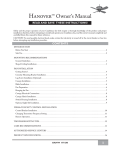

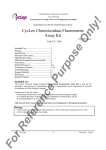
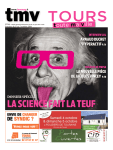
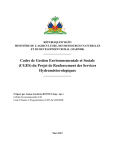


![ESCORT NON CROP LABEL REVISED [LABEL]](http://vs1.manualzilla.com/store/data/006415778_1-66433d966702e314c8c9a84af9177b1b-150x150.png)


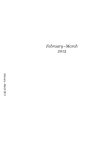

![ESCORT NON CROP LABEL REVISED [LABEL]](http://vs1.manualzilla.com/store/data/006415776_1-80ca755f50b967b81acf8adc6ac6f7ff-150x150.png)
